

Create a Narrative Writing Anchor Chart That Will Compel Your 4th, 5th, and 6th Grade Students
Creating a narrative writing anchor chart for the upper elementary classroom can effectively guide students through crafting compelling stories. An anchor chart is a visual reference that remains displayed in the classroom, offering students a quick and accessible guide to enhance their narrative writing skills. Here’s a breakdown of what you might include on a narrative writing anchor chart, along with steps in the writing process and some prompts to inspire young writers.
Keep reading to learn more!

As you begin teaching the narrative writing process, you may find an anchor chart helpful to show students a visual representation of the work they will be doing. There are many different routes you can take with the anchor chart, and you will likely find yourself creating multiple throughout the lesson. Here are a few examples of narrative writing anchor charts you may create.
1. Elements of a Narrative
One of the first steps in introducing students to narrative writing is showing them the important parts of the piece. Here are the most important ones upper elementary students should see on a narrative writing anchor chart.
- Setting: Where and when the story takes place.
- Characters: Introduce and describe the main characters.
- Plot: The sequence of events that make up the story.
- Conflict: The central problem or challenge the characters face.
- Resolution: How the conflict is resolved or addressed.
2. Narrative Writing Structure
Once you introduce students to the pieces needed to create a compelling narrative, you have to show them the framework for the writing. No one wants a story that’s all over the place. Following this simple structure will help. Lay it out on a narrative writing anchor chart for clarity.
- Hook the reader with an engaging opening.
- Introduce the characters and setting.
- Develop the plot through a series of events.
- Build suspense and tension.
- Show character reactions and emotions.
- Resolve the conflict.
- Provide a satisfying ending.
3. Writing Techniques
Kids will begin to master the initial concepts of writing, and as they do, you can encourage them to better their writing each time they start a new piece. This is where you create a narrative writing anchor chart about making the writing better each time! Give them these tips:
- Descriptive Language: Encourage the use of vivid and sensory details.
- Dialogue: Teach students how to use dialogue to bring characters to life.
- Transitions: Show how to use transitional words and phrases to guide readers through the story.
- Show, Don’t Tell: Emphasize the importance of showing actions and emotions rather than just telling.
4. Revising and Editing
This is the step most students dislike the most, but it’s the most important. Emphasize to your students how necessary it is to check work. Here are some common ways to edit a draft and make it as perfect as possible!
- Peer Feedback: Encourage students to share their writing with peers for constructive feedback.
- Self-Editing: Teach basic editing skills, focusing on grammar, punctuation, and spelling.
- Revising for Clarity: Emphasize the importance of clarity in storytelling.
5. Narrative Writing Prompts
To get you and your students started, use a few of these narrative prompts . Display them on a narrative writing anchor chart and let them choose as they begin.
- Write about a time when you faced a challenge and overcame it.
- Imagine you discover a magical object. Describe the adventure that follows.
- Create a story set in a futuristic world where technology has taken over.
- Write about a memorable moment from your summer vacation.
- If you could travel back in time, what historical event would you visit, and why?
6. Writing Process
To sum it all up, here is how students should naturally start and end their writing process! Practice over and over so they get the hang of it; in no time, they will be masters.
- Brainstorming: Generate ideas and plan the story.
- Drafting: Write the initial version of the narrative.
- Revising: Make improvements to the content and structure.
- Editing: Correct errors in grammar, punctuation, and spelling.
- Publishing: Share the final, polished narrative.
By incorporating these elements into a narrative writing anchor chart, students can refer to it as a constant reminder of the key components and techniques needed for successful storytelling. This visual aid can be a valuable resource in fostering a supportive and creative writing environment in the upper elementary classroom.
More Posts about Narrative Writing
- 20 Inviting Narrative Writing Example Prompts for Upper Elementary Students
- Vocabulary Words for 6th Graders Can Be Exciting and as Simple as 1-2-3
- 4 Exciting Prompts for Narrative Writing That Will Spark Creativity
- A Useful Guide to Using a Narrative Writing Graphic Organizer for Kids

You might also like these posts:

Utilizing Classroom Centers in 5 Powerful Ways
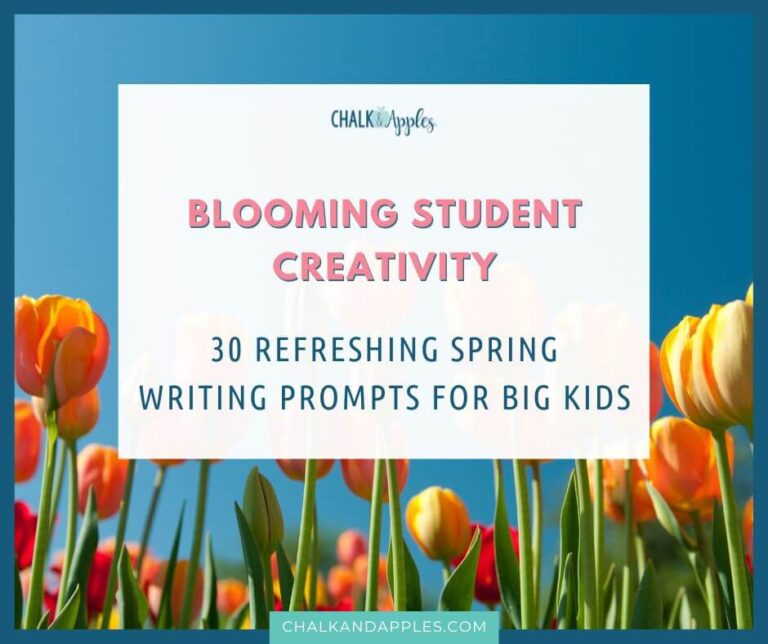
Blooming Student Creativity: 30 Refreshing Spring Writing Prompts for Big Kids

What are Text Structures Anchor Charts, and How Can Teachers Use Them to Their Advantage?

Common and Proper Noun Worksheets Are Boring! Try These Exciting Activities Instead!
Shop teacher favorites.
Find ready-to-go lessons, activities, and organizational tools to simplify your life and help you fall back in love with your job.

Reading Digital Rotation Board with Timers (Editable)

Digital Rotation Boards for Reading & Math (Bundle)
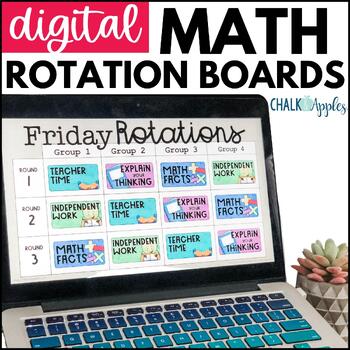
Math Digital Rotation Board with Timers (Editable)

Word Work for Big Kids: PRINTABLES for Vocabulary

Great Mail Race Complete Kit
Free teaching resources, join the newsletter.
Get teaching tips, resources, and freebies delivered right to your inbox once a week!
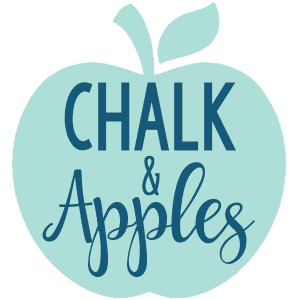
- Terms of Use
- Disclaimers
- Privacy Policy
- Resource Shop
- Access Purchases
The Community
We weren't meant to do this teaching life alone... we need each other. Join our Upper Elementary teacher community on Facebook for tips, ideas, and support from people who get it... teachers just like you!

Language & Grammar

Science & Social Studies

Digital Learning
7 strong narrative writing anchor charts.

Narrative Writing is my personal favorite type of writing to teach. The creativity and possibilities that come with this type of writing are endless! Today, we are going to take a look at 7 strong anchor charts for teaching narrative writing. Anchor charts are always a great tool for introducing or even revisiting a skill. In this case, the anchor charts are going to help students better understand the requirements and structure of narrative writing.
Introduce the Narrative Writing Structure

First, students will need to know what Narrative Writing is! Students will be tasked with writing narrative stories throughout their education. The anchor chart above divides the topic into personal and fictional narrative writing. Initially, students will be writing stories about events that they experienced, personal narratives. However, writing those personal stories will help students develop writing skills that will enhance their fictional narratives, too!
Next, you will want to show students the narrative writing structure. This anchor chart displays the narrative writing structure as a hamburger [or veggie burger :)]. I like to think that this structure image helps students remember that you can fill your burger with yummy ingredients (events and details), but it also needs a top and bottom (an introduction and conclusion).
Teach Students to Focus on Small Moments
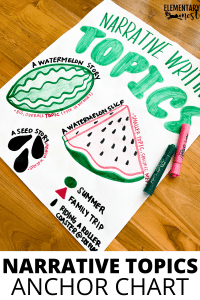
Now, students will need help narrowing their writing ideas down to a specific event. This concept is more difficult for students to understand than one would think. So, we like to use a watermelon as a metaphor.
The whole watermelon represents a broad topic or big idea, like “Summer.” You wouldn’t want to write about your entire summer in one story. So, you take a slice out of that watermelon. Maybe your family took a trip or did something fun together over the summer. The slice may represent a “Family Trip.” Within that slice, there are seeds or specific events/things that were memorable on the trip. For example, maybe it was your first time riding a big roller coaster, you made a friend at the playground, built a sandcastle at the beach, made cookies with your grandmother, etc.
Choosing one of those memories and zooming in on the details and feelings of the moment will make for a much better story than simply writing about summer.
Focus on Aspects of the Body of Writing

Our next Narrative Writing Anchor Chart will focus in on the Body of the piece. This will be all of those yummy ingredients within your story burger! You will want students to remember that a story has a beginning, middle, and end. They also need to know that within those parts, there needs to be detail and description that engages the reader. *This chart can also be made with a simple, 3-row chart where you could provide an example of each event with details. OR laminate it and reuse it over and over!
Feelings and actions are very important to narrative writing. I recommend having a mini-lesson where students can get involved in the making of a feelings and actions anchor chart. Discuss different feelings and emotions you may experience during a memorable event. Then, talk about the actions that you may do during the event or during those emotions.
Teaching Introductions and Conclusions Explicitly

Finally, you are going to need to talk about those buns! The introduction and conclusion parts of your story burger are just as important as the middle. Many times, it is more effective to write introductions and conclusions after the body of the piece has been written. Be sure to provide examples of different types of hooks and closings from narrative stories you may have read. This is a great opportunity to refer back to mentor texts you have already read. Revisiting just the introduction and conclusion, students will remember how those stories were as readers. It will help them, creatively, and keep them developing their skill!
These simple narrative writing anchor charts are going to be great tools to refer back to throughout the year!
Interested in Free Graphic Organizers for Your Writing Unit?
Or do you want ready-made lesson plans for narrative writing.
If you’re interested in getting your students to master writing without having to spend hours on planning and prep, I have all-inclusive units for you! These no-prep units have everything you need to teach opinion writing in your classroom!

Narrative Units come complete with anchor charts, lesson plans, graphic organizers, writing prompts, and more! Click the button for your grade-level below:
Want to learn more about teaching Narrative Writing?
- Mentor Texts for Narrative Writing
- How to Teach Narrative Writing
- The Importance of Pre-Writing
- Read more about: Anchor Charts , Common Core Aligned , Writing Blog Posts
You might also like...

3 Easy Times to Squeeze Speaking and Listening Skills into Your Day
In today’s blog post we will talk about incorporating speaking and listening skills in your elementary classroom! Finding time to focus on these crucial skills

Introduction to Fractions: Partitioning, Shares, and Fractions in 1st and 2nd Grade
Hello teachers! Welcome to today’s blog post, where we will dive into the fascinating world of fractions, tailored specifically for 1st and 2nd-grade classrooms. Fractions

Teaching Text Features in the Spring
This isn’t the first time we’ve discussed using the current season as a way to make your ELA content more engaging. Adding the element of
Join these happy teachers
Join the email list.
Get teaching tips, how-to guides, and freebies delivered right to your inbox every Wednesday!
Hi, I'm Jessica

I help elementary teachers master the standards by providing helpful standards-based tips, guides, and resources.

Let's Connect
Access your purchases
© Elementary Nest • Website by KristenDoyle.co


Want 20% off your first purchase?
5 must-have anchor charts to teach personal narratives.
Teaching personal narratives is always fun. Kids love to tell stories and putting their stories to paper is exciting, but it can also be challenging. Focusing on one memory or event, zooming in on the moments that are worth telling, and captivating their audience in the process are all a part of the narrative writing process that helps students develop as storytellers and writers.

Carefully developing mini-lessons that will help students as they write their own personal narratives is an important part of planning your narrative writing unit. Here are a few ideas for anchor charts as you are planning your narrative writing unit.

1. Thinking of ideas
Narrative writing tells a story and a personal narrative tells a story from your own experiences. Discuss personal narratives, important parts to include in a personal narrative, and how to think of ideas for your personal narrative.

Have students think of ideas and share topics that could be their own personal narratives. Have them generate a list of their own ideas.

2. Elements of a personal narrative
Discuss the story elements of the story: the setting, characters, problem, solution, and how a story has a clear beginning, middle, and end. As authors, we have to limit the number of characters and places the characters visit so that we are staying zoomed in on small moments.

Create an anchor chart of story elements that students will include in their personal narrative. Encourage students to consider where their memory or event took place, use a sequence of events so that it is clear to the reader, add details that are important and stick with the small moment of the memory, develop the characters to help the reader get to know them, show your feelings, use your voice as a writer.
These are all ideas that will help as students begin their writing. Incorporating all of these elements in a clear and concise way will keep the story interesting to your reader.
3. Using voice in your writing
When you put feelings into your writing, your reader will get to know you and your story will be one that they want to read. Encourage students to use voice in their writing so that their writing sounds like them. Their voice becomes their own writing style and writing personal narratives is the perfect time to explore that style. You can use vivid language and details, express thoughts and feelings, and let your personality show.

Students are the experts of their own narratives!

4. When to start a new paragraph
Students become so focused sometimes on how long a paragraph needs to be that they forget that the quality of the paragraph is just as important as the length.

Discuss with your students:
- A paragraph starts on a new line and indents.
- Use transition words to change paragraphs smoothly.
- When do we start a new paragraph?
- Should we simply count 5-6 sentences and then indent?
Create an anchor chart as a reminder to start a new paragraph when someone new is introduced in the story, when a new event occurs, when a new person is speaking, when the setting changes, or the topic/idea changes.
5. Adding in more details
Adding details to writing while revising is an important step because while writing personal narratives only your students know the details of their stories. They want their readers to know all they need to know!

How can you add details?
- Add in adjectives
- Show more action, use verbs to help show the action
- Use dialogue when you can
- Show your feelings about the events/memories
- Add in details that only YOU know! Your reader was not there, but YOU were!

Looking for more ideas for writing workshop?
You can find more tips and ideas for narrative writing in this post.
Find some ideas and tips for persuasive writing in this post.
And check out all of my posts about writing workshop in one place!
Shop the resources featured in this post:
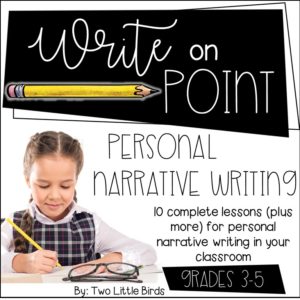
Happy writing!

- WordPress.org
- Documentation
- Learn WordPress
- Members Newsfeed
15 Clever Anchor Charts for Teaching Story Elements

Introduction:
In order to help students understand the different story elements and their significance, teachers often use anchor charts as visual aids. Anchor charts serve as a valuable resource for students to refer to when analyzing and discussing various aspects of a story. Here, we have compiled 15 clever anchor charts that can be used to teach story elements effectively in the classroom.
- Character Traits Chart:
Create a chart that lists various character traits, such as brave, curious, or dishonest. Show examples of characters from different stories and ask students to identify and explain the traits that apply to each character.
- Plot Structure Chart:
Break down the story structure into key components, including exposition, rising action, climax, falling action, and resolution. Use visuals to illustrate each stage and encourage students to identify these elements in the stories they read.
- Setting Chart:
Highlight the importance of setting by displaying a chart that features different settings, such as a bustling city or a tranquil countryside. Ask students to analyze how the setting impacts the events and characters in a story.
- Conflict Types Chart:
Introduce different types of conflicts, such as person vs. person, person vs. nature, person vs. self, and person vs. society. Provide examples and encourage students to identify the type of conflict in various stories.
- Theme Chart:
Help students uncover the themes in stories by creating a chart that showcases common themes, such as love, friendship, or perseverance. Display examples of books or short stories that explore these themes.
- Character Development Chart:
Demonstrate the changes characters undergo throughout a story by creating a chart that shows their traits at the beginning, middle, and end. Encourage students to discuss the reasons behind these changes.
- Point of View Chart:
Explain different perspectives in storytelling, including first person, third person limited, and third person omniscient. Provide examples and ask students to identify the point of view used in various narratives.
- Symbolism Chart:
Highlight the use of symbolism in literature by creating a chart that features common symbols and their meanings. Discuss how symbols enhance the reader’s understanding of the story.
- Foreshadowing Chart:
Discuss the concept of foreshadowing and its purpose in storytelling. Create a chart that showcases examples of foreshadowing in different texts, and encourage students to predict the events based on these hints.
- Tone and Mood Chart:
Help students analyze the tone and mood in stories by using a chart that presents various emotions and the words that convey them. Ask students to identify the tone and mood in different passages.
- Flashback Chart:
Explain the use of flashbacks in narratives and how they contribute to the story. Display a chart that provides examples of flashbacks in literature, and encourage students to discuss their impact.
- Dialogue Chart:
Explore the significance of dialogue in storytelling by creating a chart that showcases different ways to use dialogue effectively. Provide examples and encourage students to write their own dialogues.
- Metaphor and Simile Chart:
Introduce students to figurative language by displaying a chart that presents examples of metaphors and similes. Discuss their purpose in storytelling and encourage students to create their own comparisons.
- Irony Chart:
Explain the concept of irony and its various types, such as verbal, situational, and dramatic irony. Provide examples and ask students to identify instances of irony in texts they read.
- Descriptive Language Chart:
Emphasize the importance of descriptive language in creating vivid imagery. Create a chart that showcases different types of descriptive language, such as sensory details, vivid verbs, and similes.
Conclusion:
By using these clever anchor charts for teaching story elements, teachers can help students develop a deeper understanding of storytelling and improve their analytical skills. Encourage students to refer to these charts regularly as they explore the world of literature. Happy teaching!
Related Articles

The first year of teaching can be a thrilling and challenging experience…

Dice games can be a fantastic tool for teachers looking to incorporate…
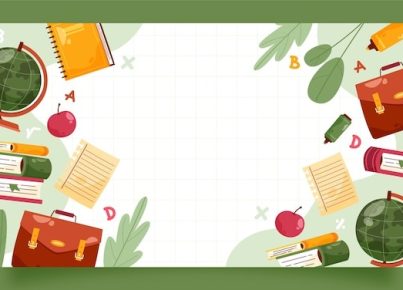
In the ever-changing landscape of education, teachers constantly find new ways to…

Pedagogue is a social media network where educators can learn and grow. It's a safe space where they can share advice, strategies, tools, hacks, resources, etc., and work together to improve their teaching skills and the academic performance of the students in their charge.
If you want to collaborate with educators from around the globe, facilitate remote learning, etc., sign up for a free account today and start making connections.
Pedagogue is Free Now, and Free Forever!
- New? Start Here
- Frequently Asked Questions
- Privacy Policy
- Terms of Service
- Registration
Don't you have an account? Register Now! it's really simple and you can start enjoying all the benefits!
We just sent you an Email. Please Open it up to activate your account.
I allow this website to collect and store submitted data.
- Grades 6-12
- School Leaders
FREE Poetry Worksheet Bundle! Perfect for National Poetry Month.
40 Must-Have Anchor Charts for Teaching Writing of All Kinds
Writing information and inspiration for all!
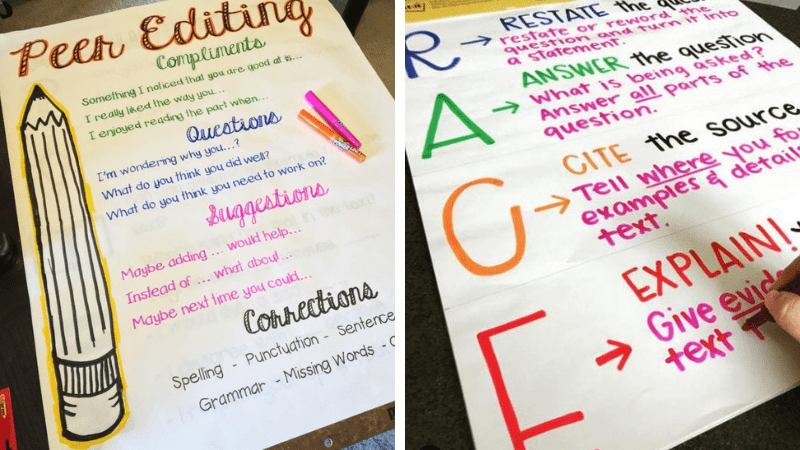
When it comes to writing, many kids struggle to get their ideas down on paper. That’s why we’ve rounded up all the best writing anchor charts, to help your students master narrative, transitions, punctuation, editing, theme, and so much more! Try some of these ideas in your classroom to give your kids the writing support they need.
1. Why Writers Write
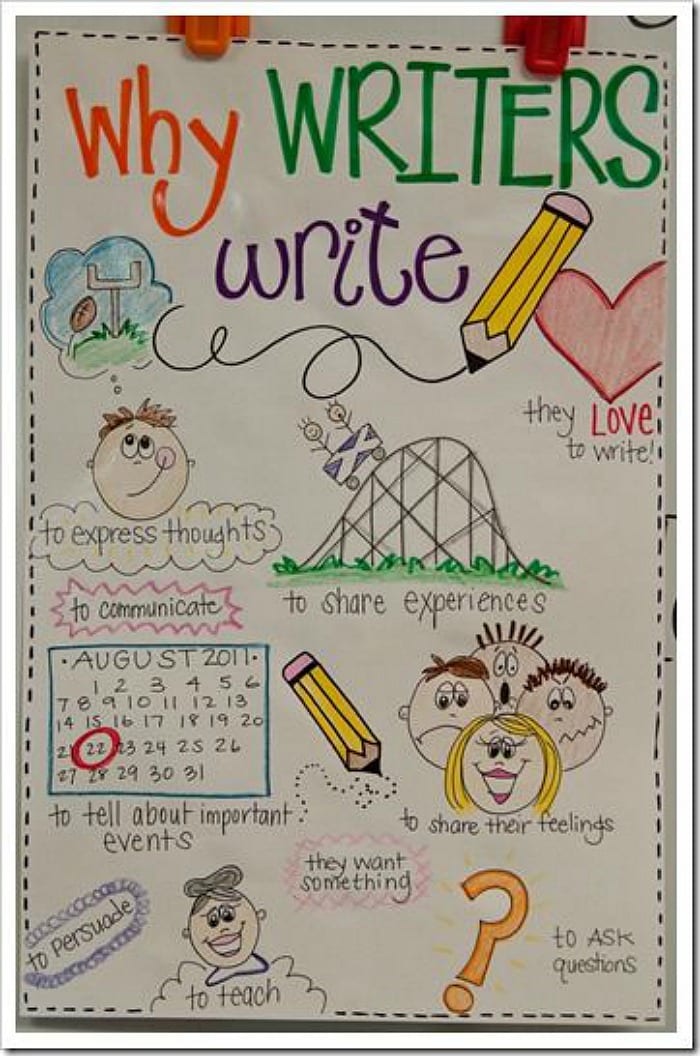
First and second graders will draw inspiration from this fun-filled anchor chart about why we write. Make this chart applicable to older students by expanding on each aspect with a specific audience or goal. “To share experiences” can become “to share experiences with friends, in a postcard, or with readers of a memoir.”
Source: Cara Carroll
2. Expanding Sentences
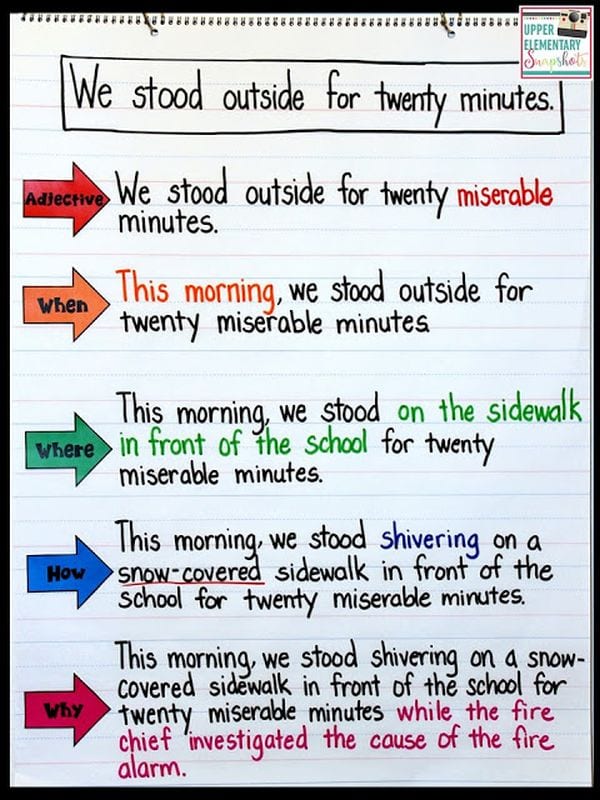
Show students how a simple sentence can become a real powerhouse by exploring when, where, how, and why, along with adding adjectives. So powerful!
Source: Upper Elementary Snapshots/Expanding Sentences
3. Personal Narrative
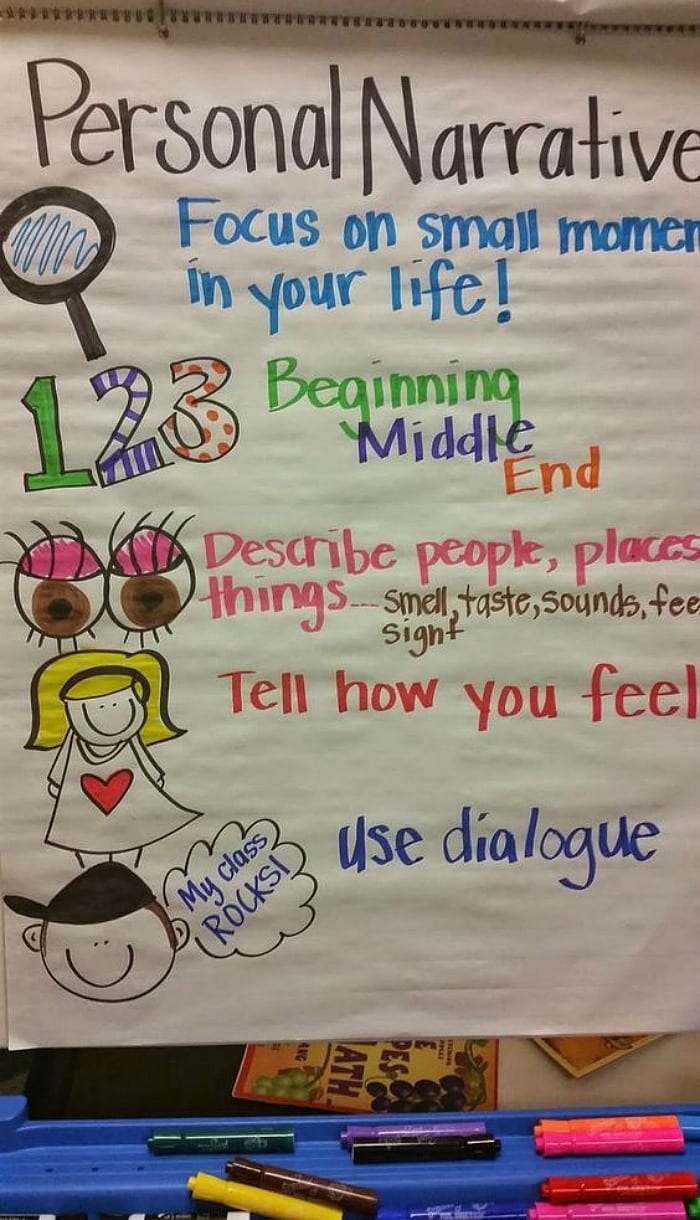
Personal narrative is a style that all students practice in elementary school, and writing anchor charts can help keep them on track. Visit the link below for great worksheets to use with your students to prepare them to write their personal narratives.
Source: Rachel’s Reflections
4. Hook Your Reader
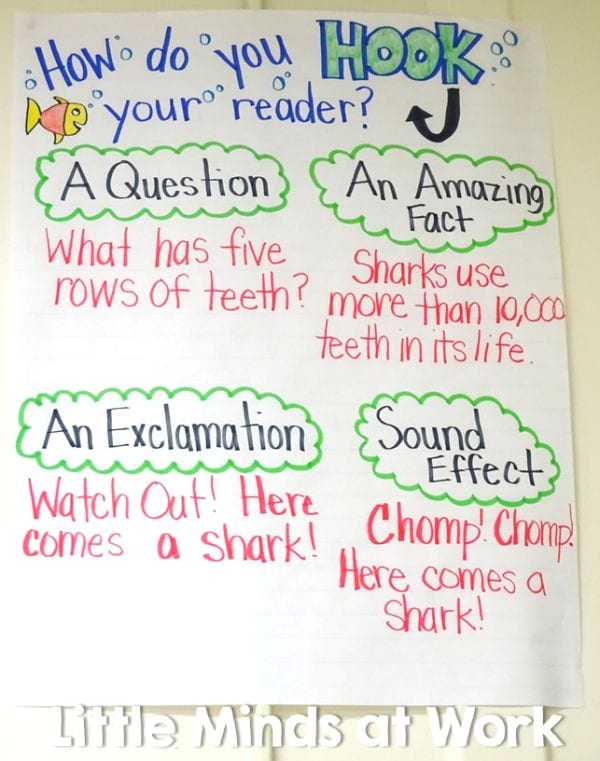
Want to know how to draw the reader in and make them eager to continue? You need a hook! Teach students how to grab a reader’s attention from the get-go, pulling them in with facts, questions, or even sound effects.
Source: Little Minds at Work
5. Point of View

Learn the differences between first person (I), second person (you), and third person (narrator), and talk about when each type is effective.
Source: Oh Boy … It’s Farley!
6. Organized Paragraph
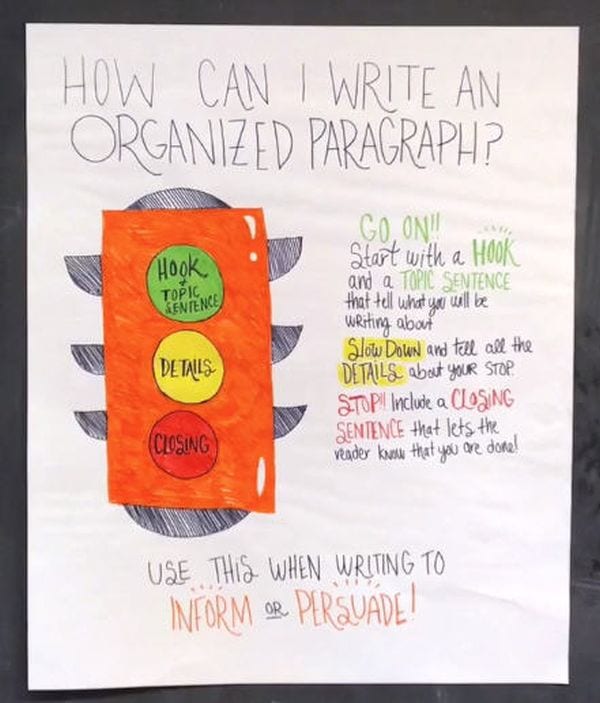
Use a stoplight to help early elementary students understand and write clear paragraphs. As students are editing their work, have them read with green, yellow, and red pencils in hand so they can see how their paragraphs are hooking and engaging readers. See a video of this chart in action here.
7. Practicing Transitions
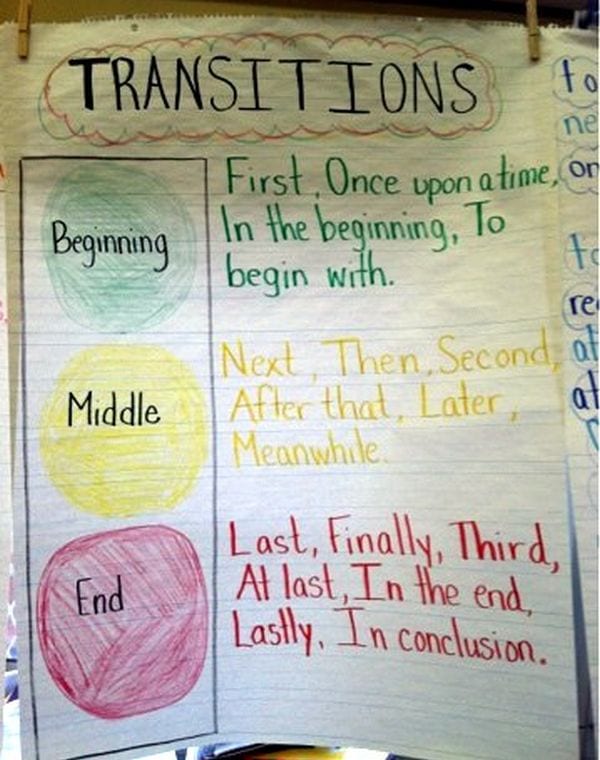
There are more stoplight writing anchor charts, and this one is perfect for helping students learn and practice their transition words. Draw the stoplight first and invite students to help come up with different words. Then encourage students to put the transition words into practice.
Source: A Happy, Hungry, Healthy Girl
8. Author’s Perspective
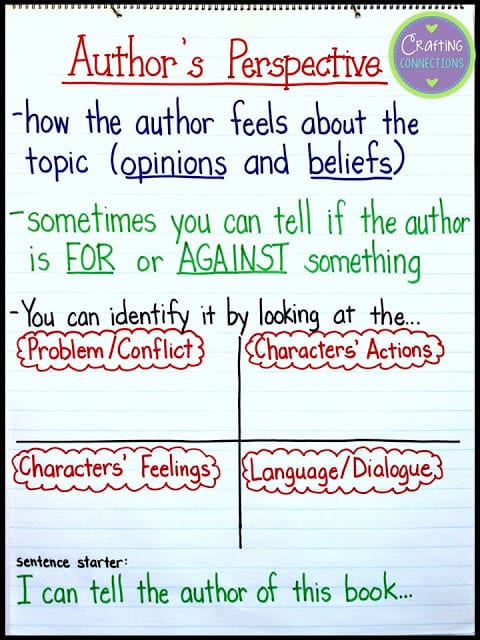
Sometimes, an author’s opinion comes out strongly in their writing, even if they don’t state it up front. Use this chart to help students find the clues to an author’s perspective.
Source: Crafting Connections/Author’s Perspective
9. Author’s Purpose Pie
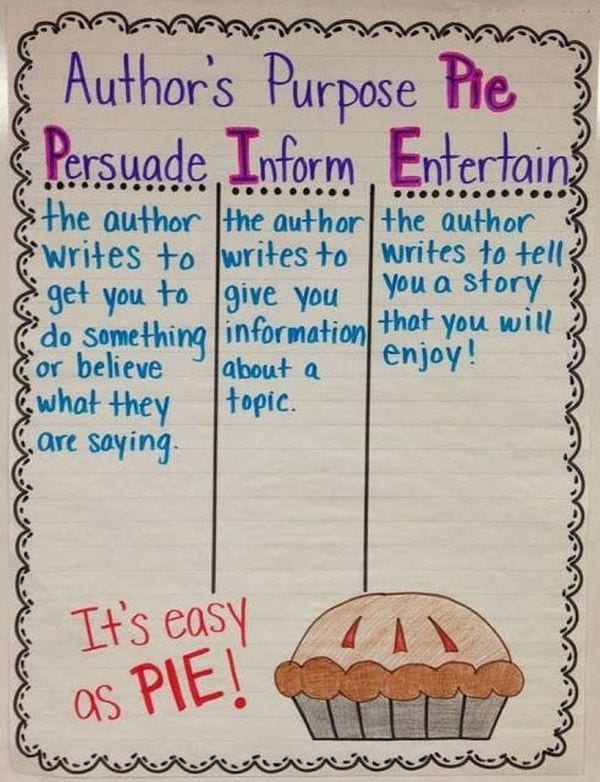
This is a quick and easy anchor chart to help students see different types of writing. It’ll also help them do a quick check to make sure their writing aligns.
Source: Literacy Ideas
10. Dig Deeper
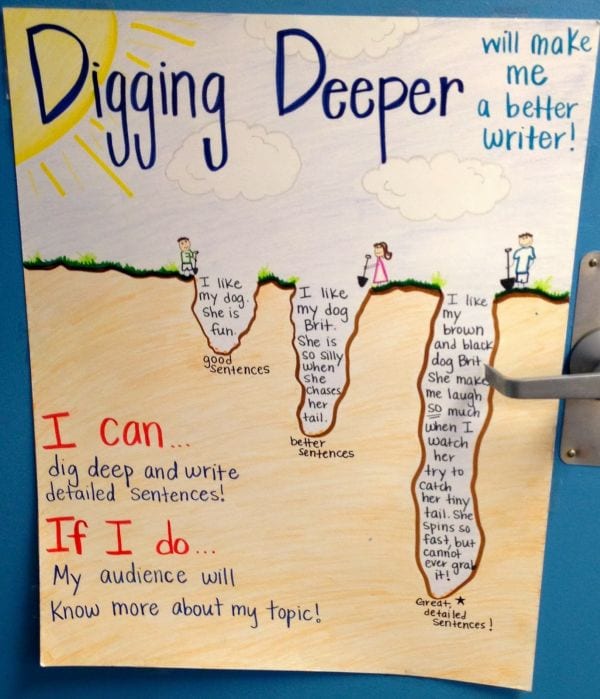
Keep going! Sometimes it’s hard to express what you mean by certain writing and revision requests, and writing anchor charts can show exactly what you mean. Now students can get a good look at what it means to dig deeper.
Source: Pinterest
11. Alternatives to “Said”
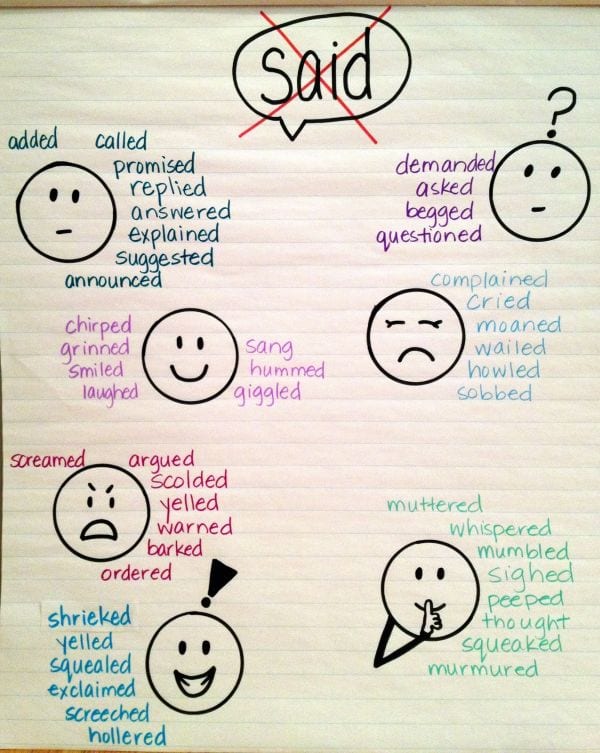
If your students are learning about writing dialogue, an anchor chart like this could really come in handy. Encourage students to try other ways to have their characters respond.
Source: ESL Amplified
12. Understanding Character
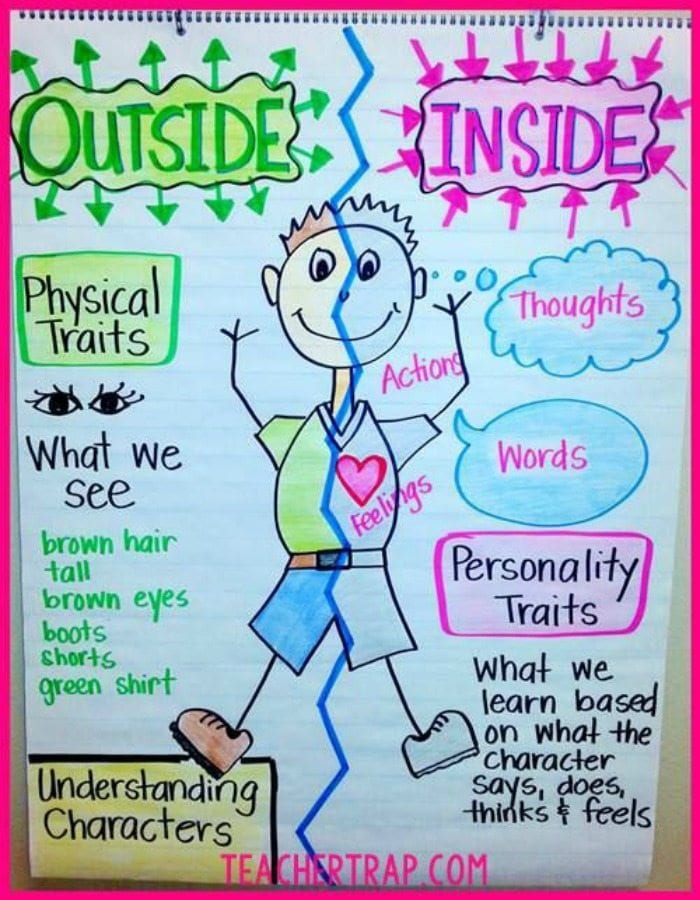
Before you can write about character, you first have to understand it. This anchor chart will help your young writers understand the difference between inside and outside characteristics.
Source: Teacher Trap
13. Diving Deeper Into Character
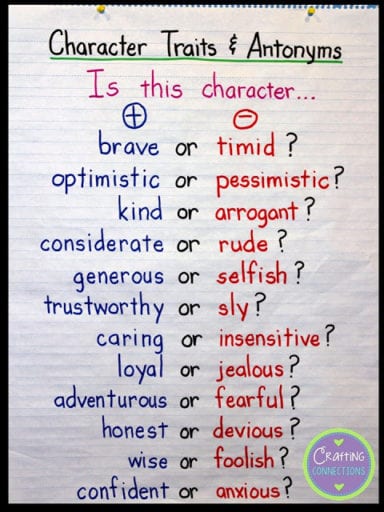
Now that your students understand the difference between inside and outside characteristics, dive deeper into describing a specific character. This anchor chart is a wonderful idea because students can write their idea(s) on a sticky note and then add it.
Source: Crafting Connections/Teach and Task Lessons
14. Six Traits of Writing
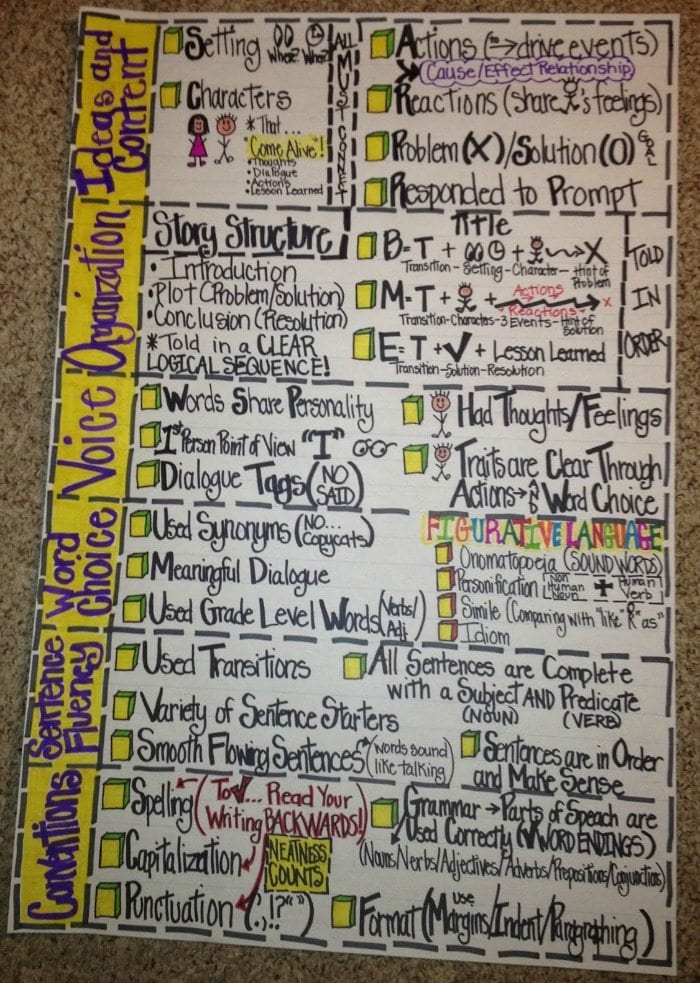
This anchor chart is jam-packed with things to help fourth- and fifth-grade writers remember the six traits of writing. Use the chart as a whole-class reference or laminate it to use in small groups. When it’s laminated, students can check off each aspect they’ve included in their own writing. Meaningful dialogue? Check! Problem and solution? Check!
Source: Working 4 the Classroom
15. Writing Realistic Fiction
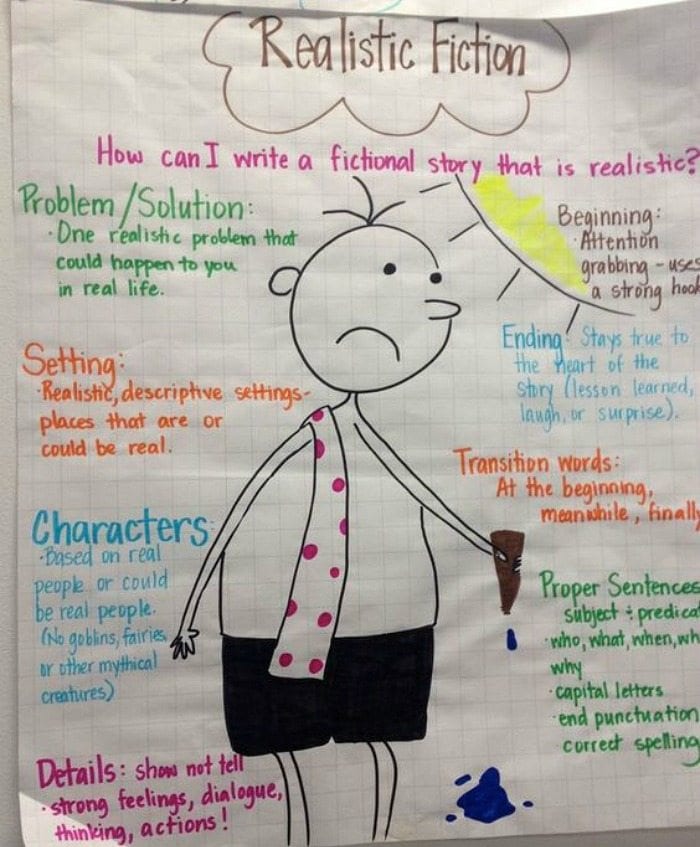
This anchor chart reminds upper elementary students how to create realistic stories. It really walks your students through the process, so they have all the elements they need to create their own stories.
Source: Two Writing Teachers/Realistic Fiction
16. Sequence of Events
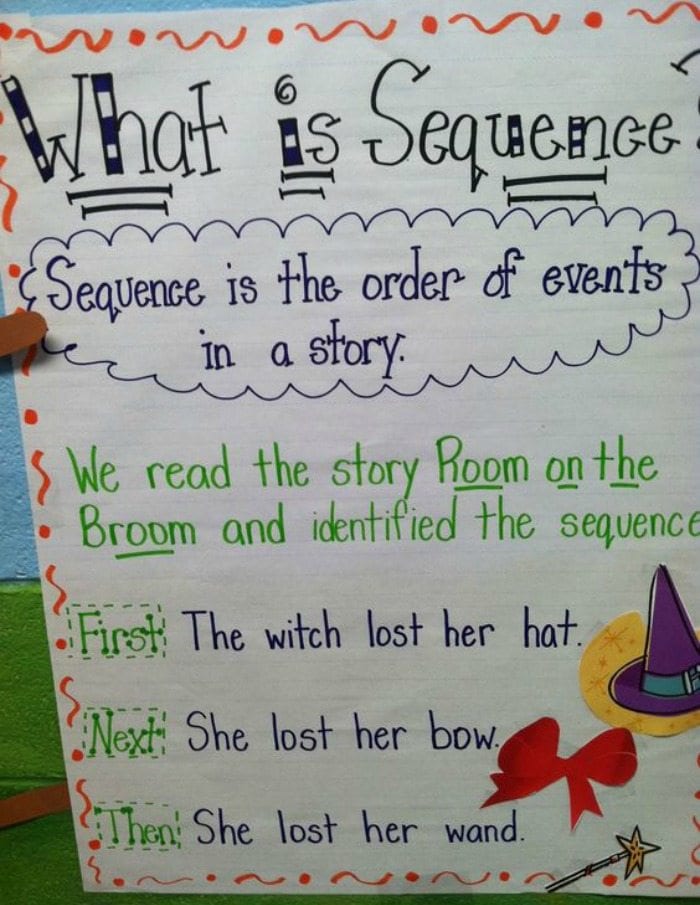
Help early elementary students stay organized with an anchor chart that’s focused on order-of-events language. Tactile learners can write their first drafts on sentence strips and use this format to put the events in order before they transcribe their work onto writing paper.
Source: Life in First Grade
17. Informational Text Structures
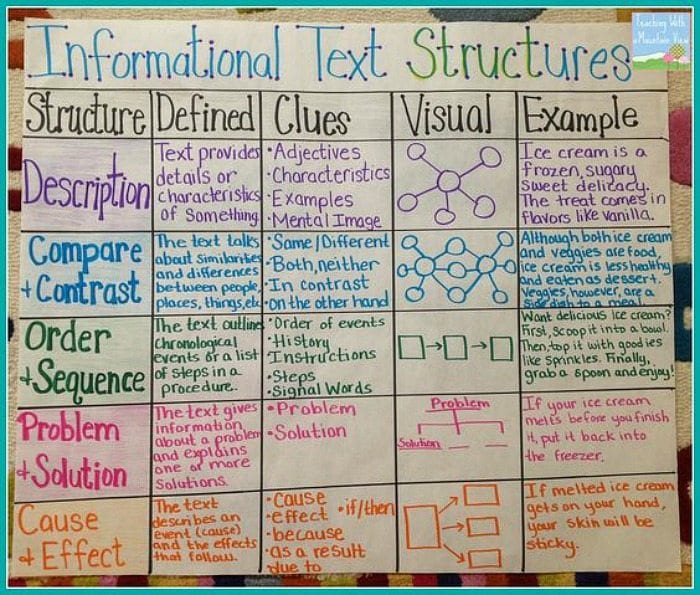
Focus upper elementary students on the most important aspects of informational writing while keeping them organized. This chart could be used to support paragraph writing or essays.
Source: Teaching With a Mountain View/Informational Text Structures
18. OREO Opinion Writing
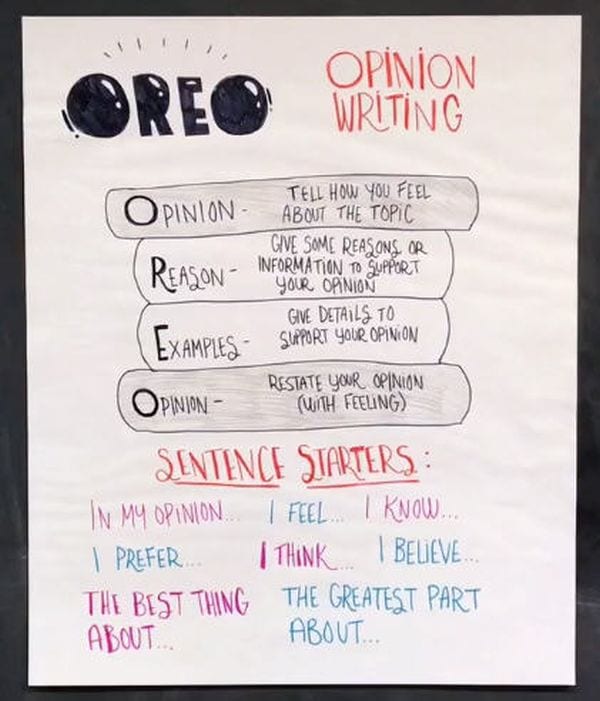
This deliciously inspired opinion anchor chart can be used by students in grades 3–5 during writers workshop or when developing an opinion for discussion or debate. To build out student writing, have them “double-stuff” their OREOs with extra E examples. See a video featuring this chart here.
19. Features of a Great Report

Use examples of outstanding student work to make this anchor chart. Keep it relevant by updating the examples with student work throughout the year. In kindergarten, this will also showcase how students move from prewriting and pictures to writing words and sentences.
Source: Joyful Learning in KC
20. Write From the Heart
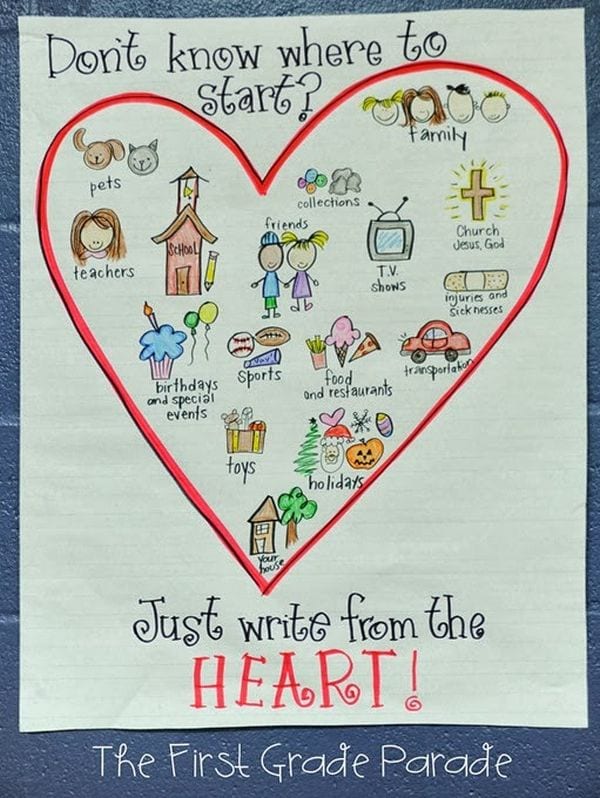
Sometimes the hardest part about writing is coming up with whom and what you should write about. This is the fun part, though! Use this anchor chart to remind your students that they have lots of good writing options.
Source: First Grade Parade via Cara Carroll
21. Argument Writing
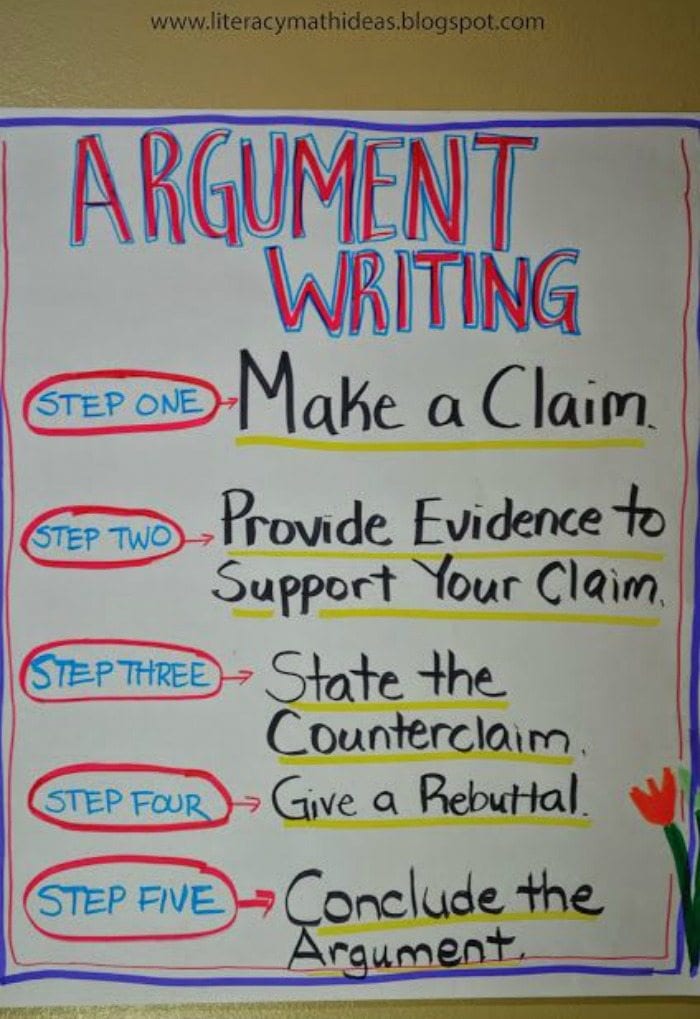
Use this anchor chart with middle schoolers to make sure they’re considering all sides of an argument, not just the one that matters the most to them. One way to adapt this chart, as students develop their understanding of argument, is to write each element—claim, argument, evidence—under a flap that students can lift if they need a reminder.
Source: Literacy & Math Ideas
22. Writing Process
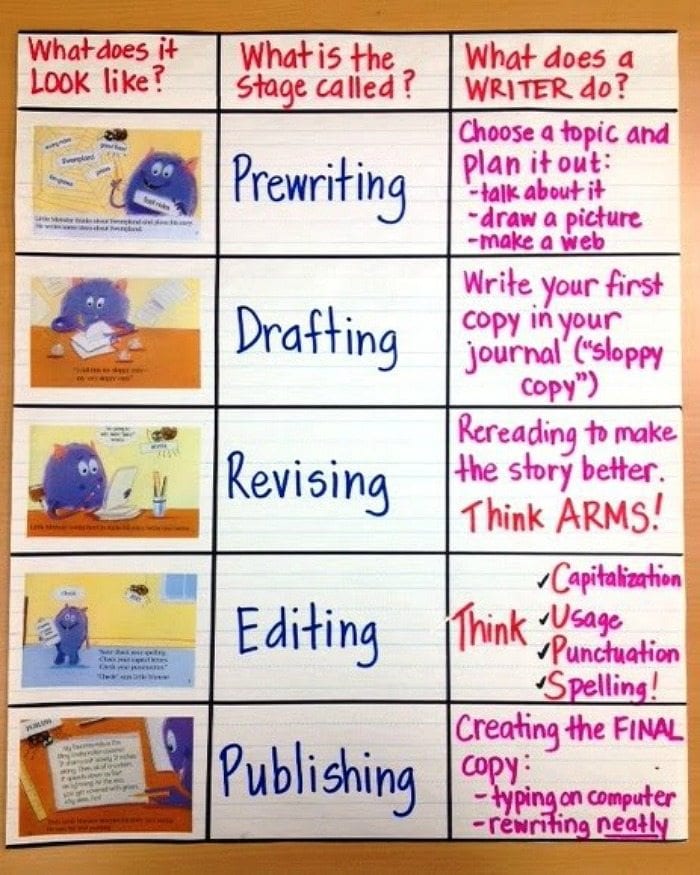
This is an anchor chart you’ll direct your students to again and again. The writing process has several steps, and it’s good to remind students of this so they don’t get frustrated.
Source: What’s Skow-ing On in Fourth Grade?

23. Writing Checklist
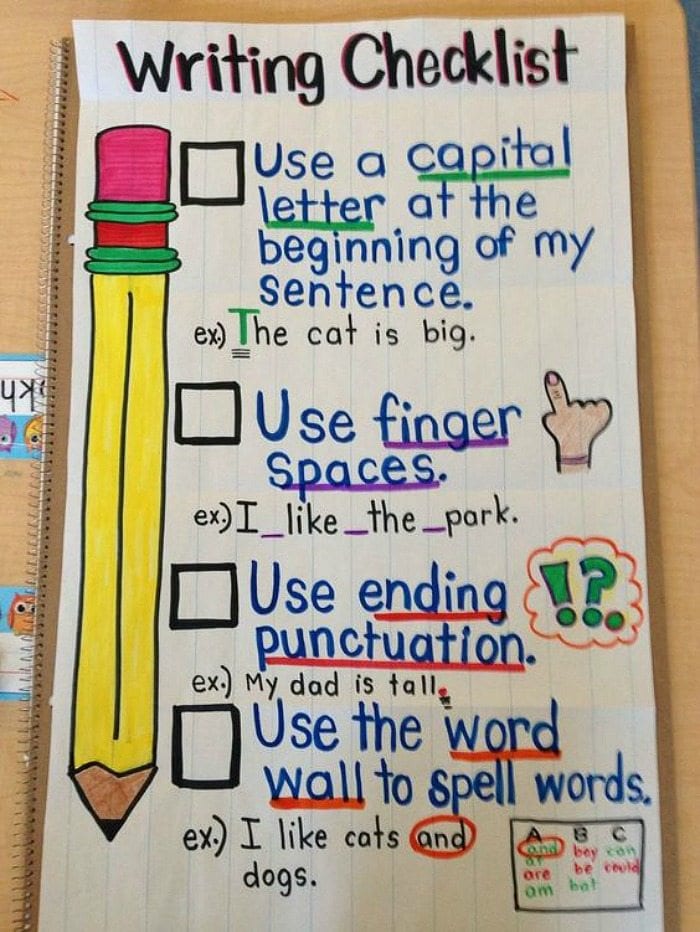
For those young writers in your class, these cover the basics in a clear way.
Source: Kindergarten Chaos
24. RACE for Writing
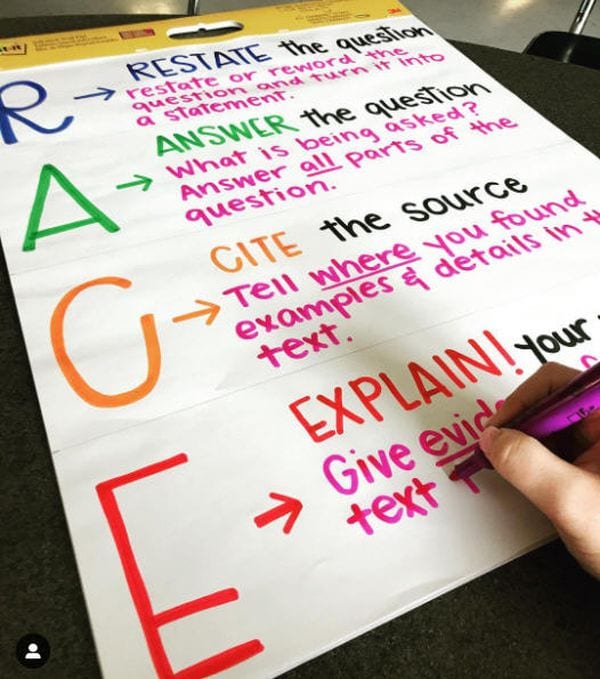
Use the RACE mnemonic when your students are working on persuasive writing. It reminds them to cite their sources and be sure to answer the question being asked.
Source: @mrspuffer
25. Cause and Effect
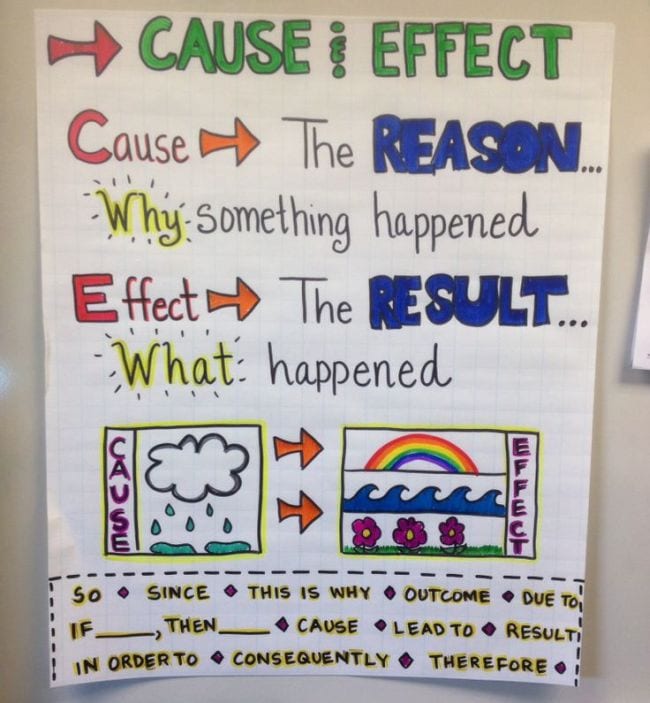
Cause and effect will always be an essential part of any story. Help your students come up with different scenarios for cause and effect. In many instances, you could have multiples effects, so challenge your students to identify three to four at a time. This will really give them something to write about!
Source: 2nd Grade Superheroes
26. A Strong Lead
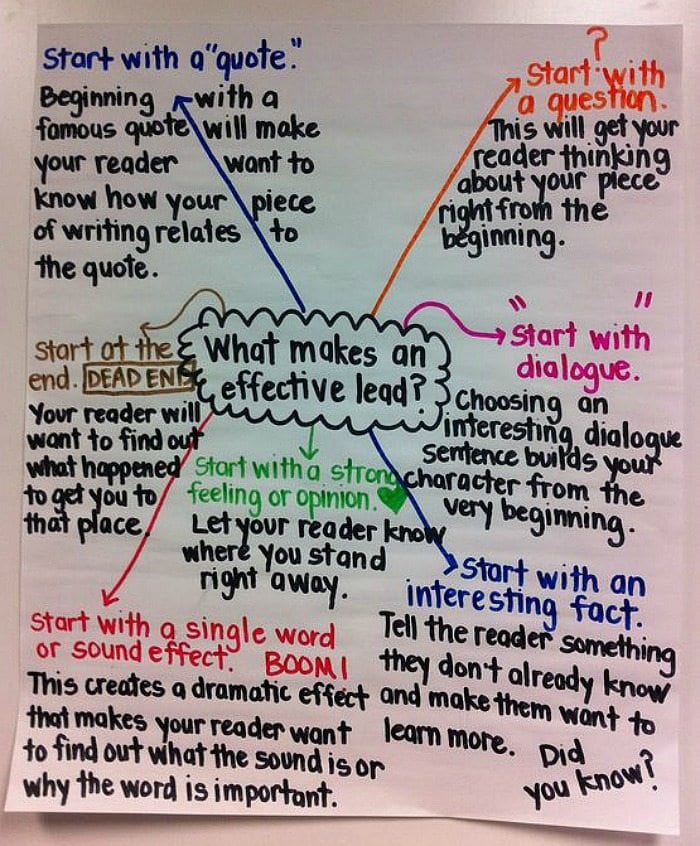
This upper-grade anchor chart gives students lots of ways to start their writing. Update it midyear with strong examples of leads that students have written or that they’ve found in books. Students could also copy this chart into their notebooks and keep track of the different ways they’ve started their own writing, seeing if they’ve developed a signature lead.
Source: Miss Klohn’s Classroom
27. Crafting Power Sentences
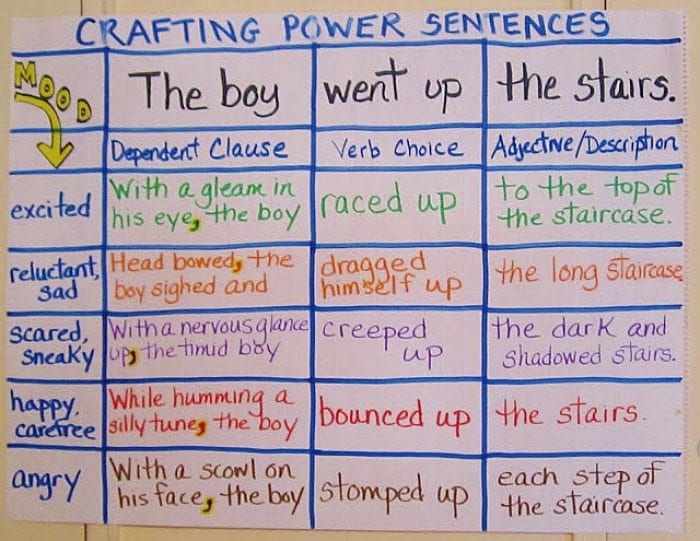
Inspire students to get crafty and creative with their sentences. Update the moods or keywords with every writing assignment, so students are constantly refining their clauses, verbs, and descriptions.
Source: Teaching My Friends
28. Show, Don’t Tell
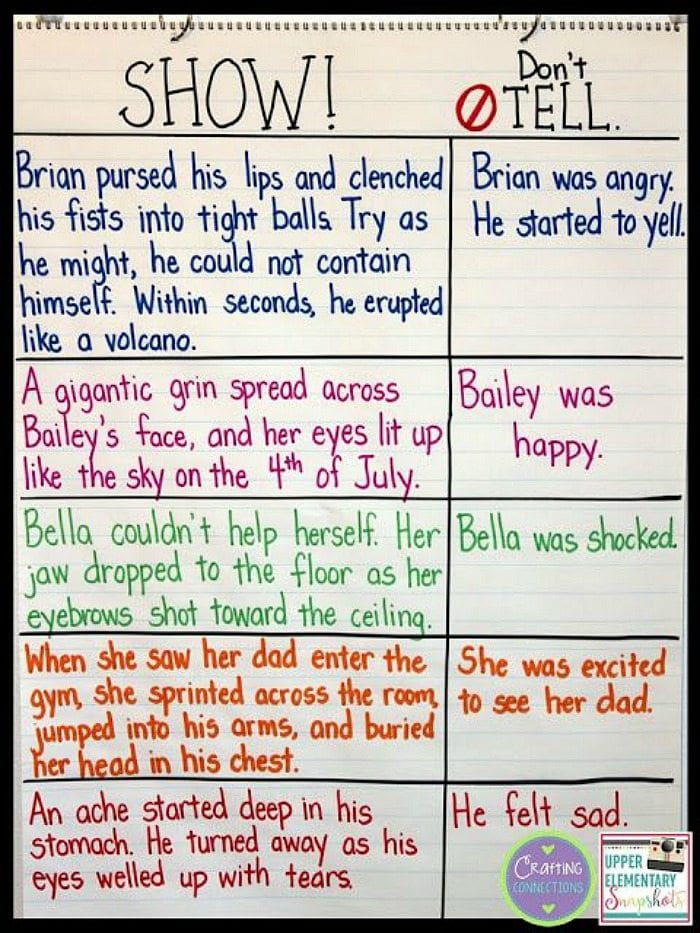
“Show, don’t tell” is a cardinal rule of writing. This anchor chart, best for upper elementary writers, can be used to strengthen scenes in fiction and narrative nonfiction works. Build out this chart for middle school writers with additional ideas and more complex emotions.
Source: Upper Elementary Snapshots/Show, Don’t Tell
29. Narrative Organizer
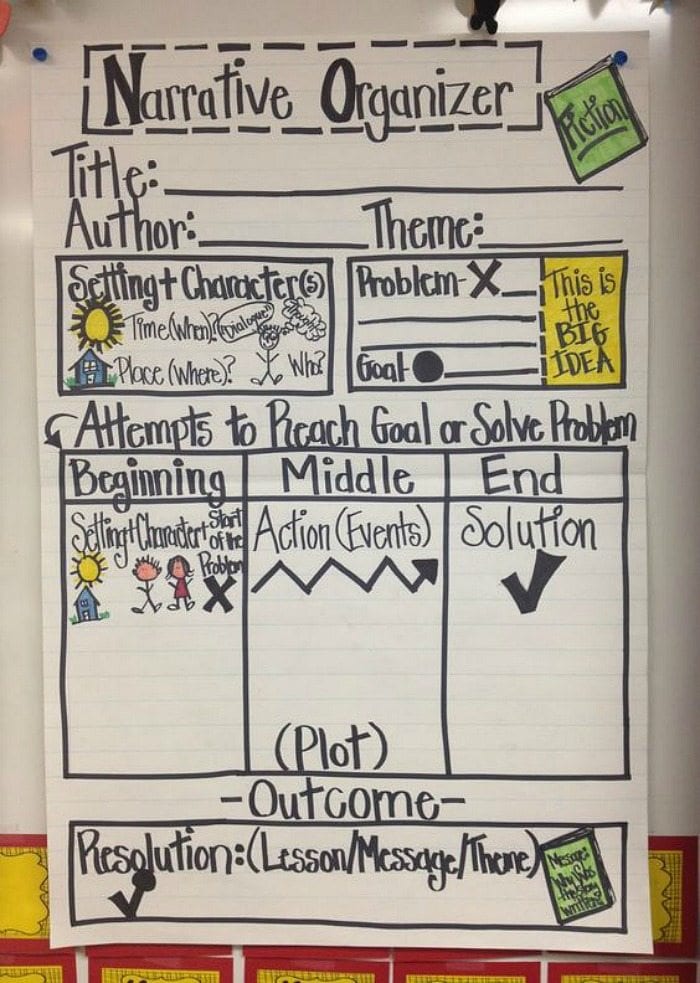
Leave this chart up in your classroom for your students to reference often when they’re writing. It really takes them through creating a successful story.
30. Expository Writing
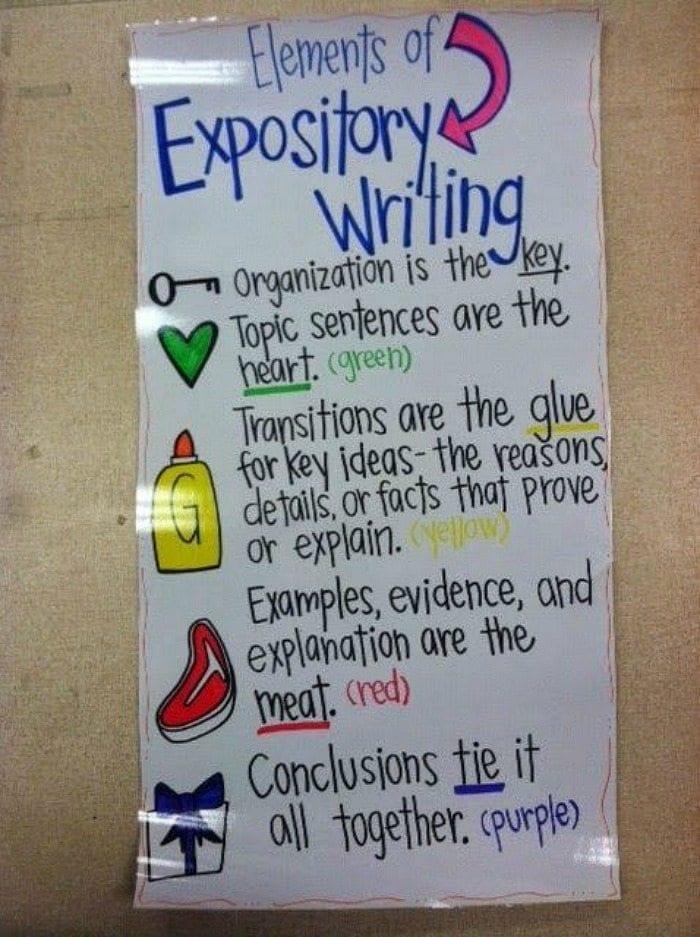
This chart makes it easy for students to remember key concepts, both with color-coding and simple metaphors. Give them colored pencils and ask them to underline the corresponding sections in their essays.
Source: Adventures of a Future Teacher
31. Peer Editing

Peer editing teaches kids a variety of skills, and not just with writing. They learn to read closely, offer (and accept) useful constructive feedback, and get more comfortable sharing their writing with others. This chart helps kids through the sometimes-challenging process.
Source: Taleof2Teachers
32. Strong Sentences
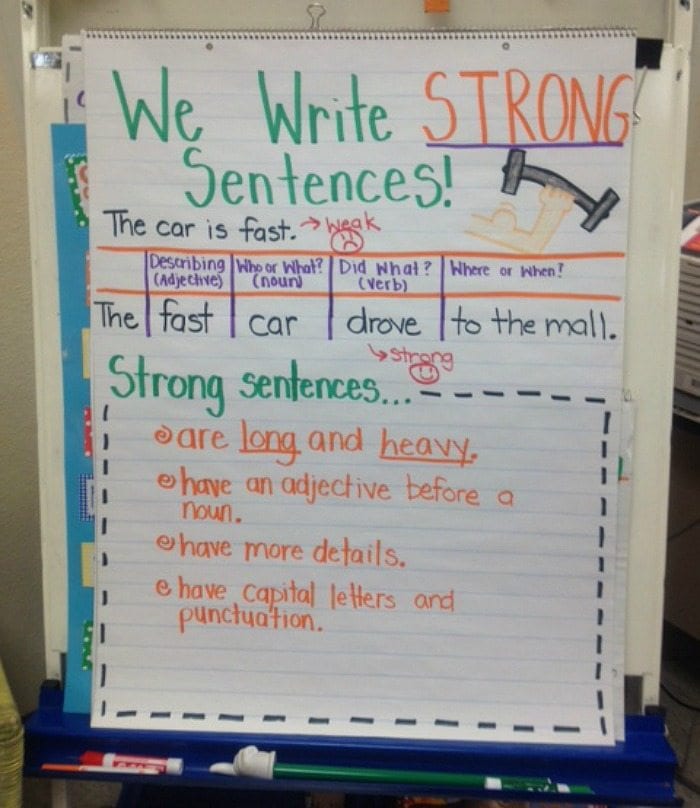
Get early elementary students to write longer, more descriptive sentences with this chart. Bonus: Use sentence strips to switch out the examples of strong sentences, based on student writing.
Source: The Good Life
33. Internal Story
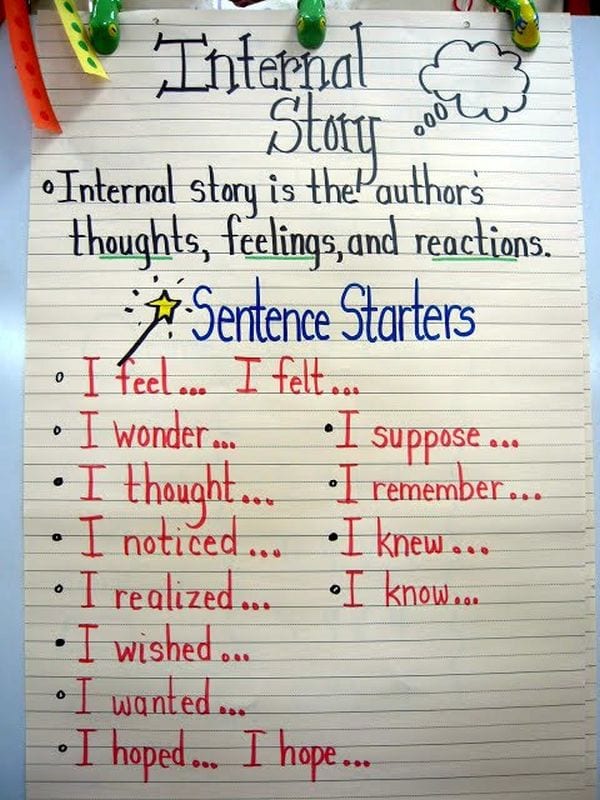
This chart gives students the language to add their own thoughts to their writing. Modify this chart by highlighting key phrases for students with special needs. Or have students create different thought-bubble icons to represent each internal dialogue sentence starter.
Source: Totally Terrific in Texas
34. Evidence Supported
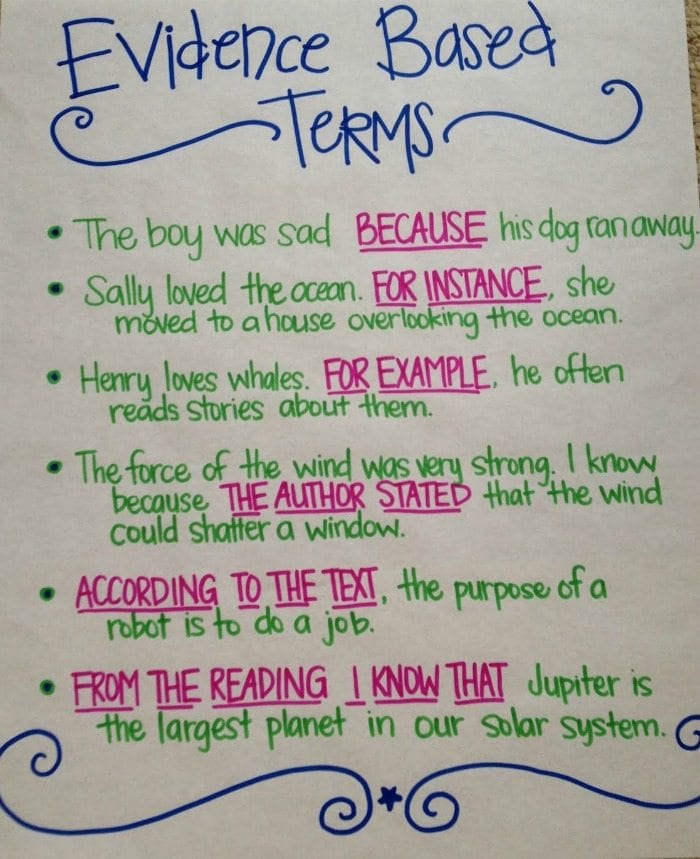
Upper elementary students will benefit from reminders on how to refer to and cite text evidence. Use this anchor chart during writing and discussion to help connect the language that we use across domains.
Source: History Tech
35. Publishing Guidelines

Kids are often quick to turn in their papers without making sure they’ve included all the necessary requirements (like their names!). Use this chart to remind them about the important things to check for before they hand in their work.
Source: Juice Boxes and Crayolas
36. Figurative Language
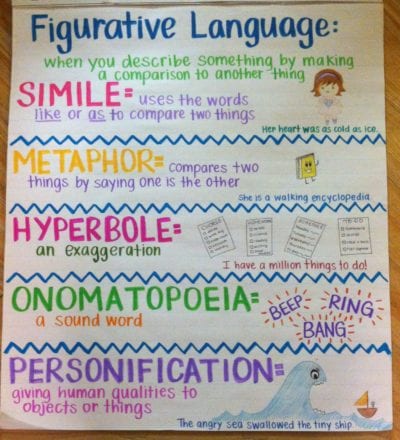
As you teach your students about figurative language and how to use it, you’ll want to have examples. This anchor chart dives into five different concepts. Each of these could actually be its own anchor chart. Perhaps have your students come up with examples on sticky notes and then place them on the chart.
Source: Willow Grove Elementary School
37. Forms of Poetry
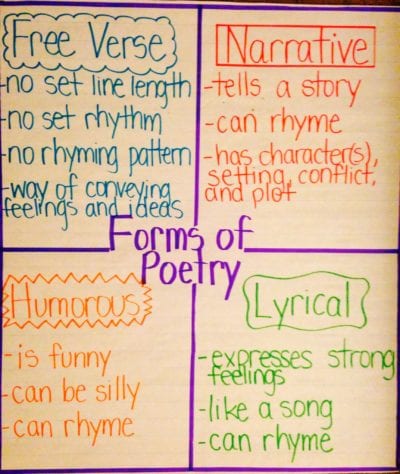
Introducing poetry types to your students? This anchor chart covers the basics and helps kids remember that not all poetry needs to rhyme.
Source: ELA Anchor Charts
38. CUPS and ARMS
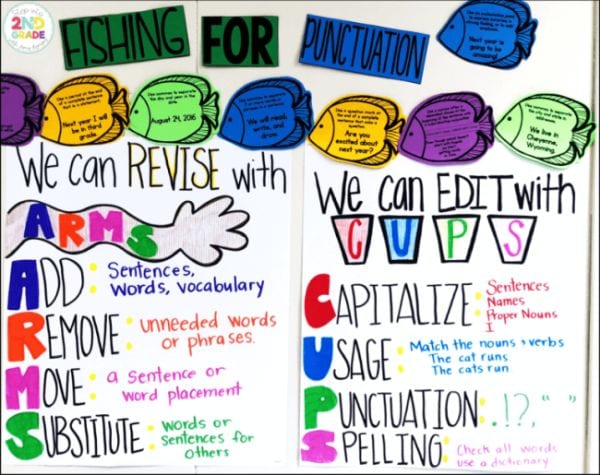
This is a popular method for teaching kids to revise and edit as well as the difference between the two. Simple acronyms keep the key strategies close at hand.
Source: Amy Lemons
39. Spicy Edits
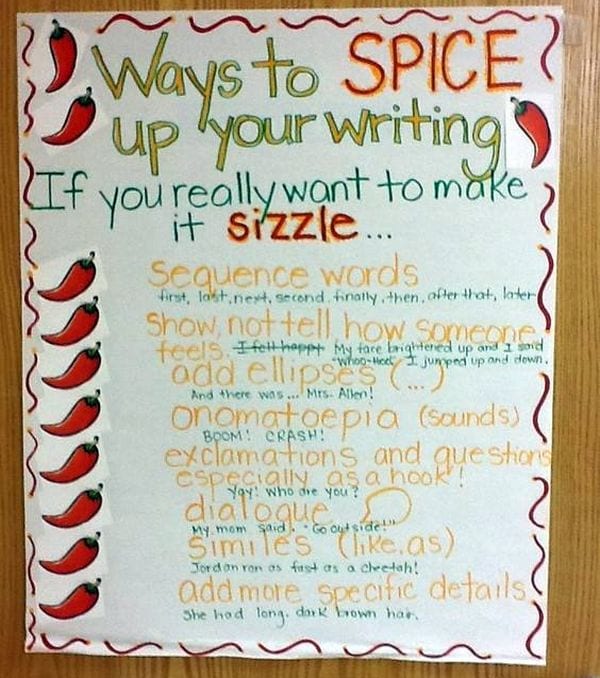
Encourage your students to think of their writing like a recipe, which they can always tweak and improve. Have them choose one element, or “spice,” to add to their work as they revise.
Source: Beyond Zebra/Pinterest
40. Writing Buddies
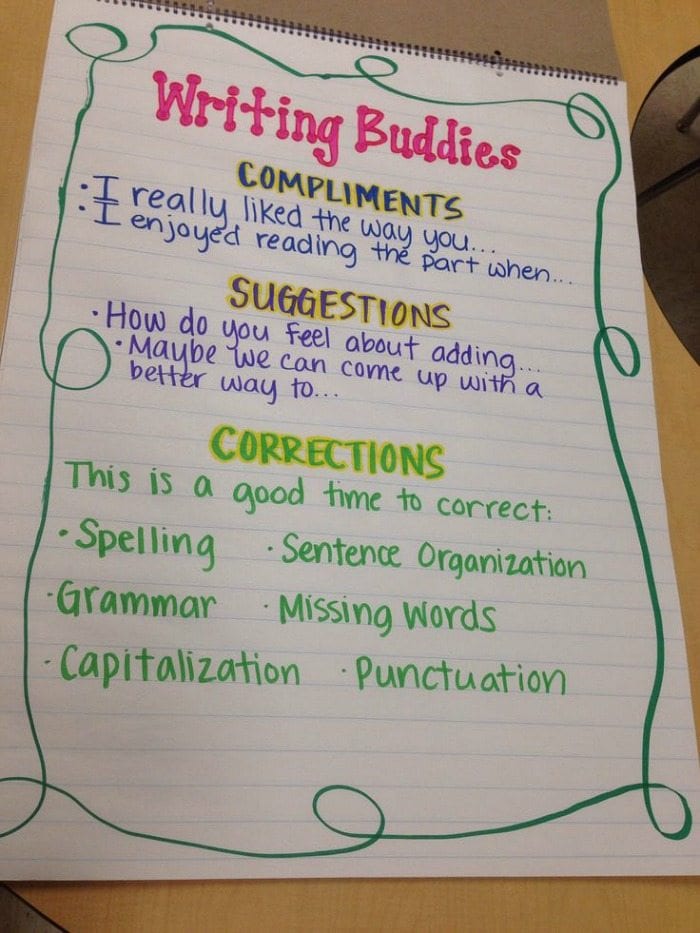
Sometimes students can get stuck when working with writing buddies, but writing anchor charts can help. This one encourages students to be positive and make good, thoughtful suggestions.
Source: Apostrophe Books Twitter
What are your favorite writing anchor charts? Share your ideas in our WeAreTeachers HELPLINE group on Facebook.
Plus, find out why the “hamburger” essay has gone stale, and what to try instead ..
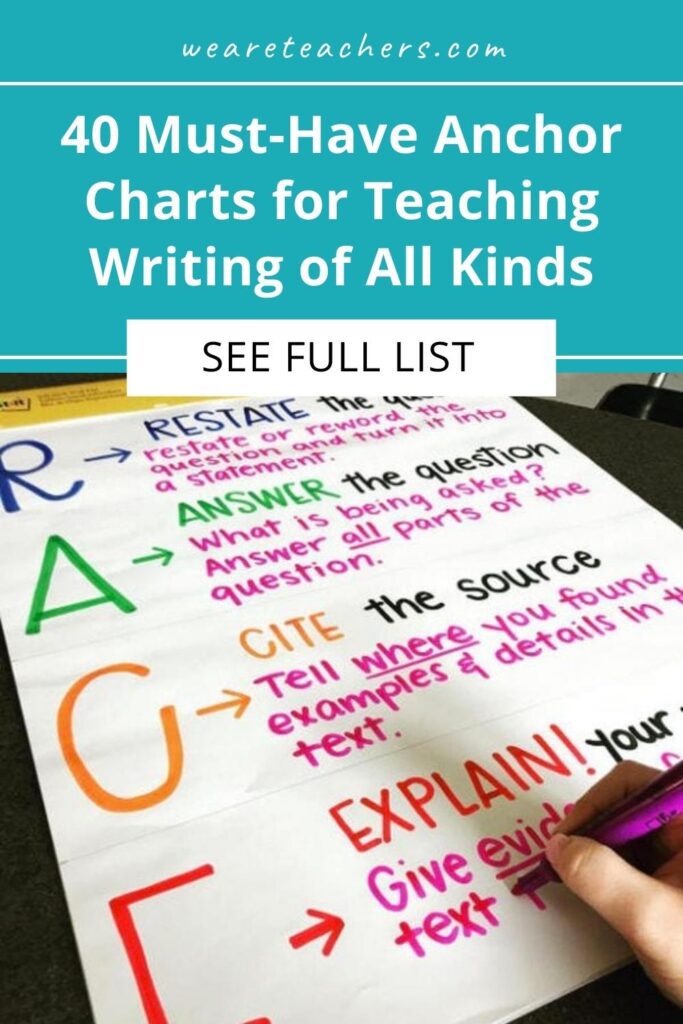
You Might Also Like
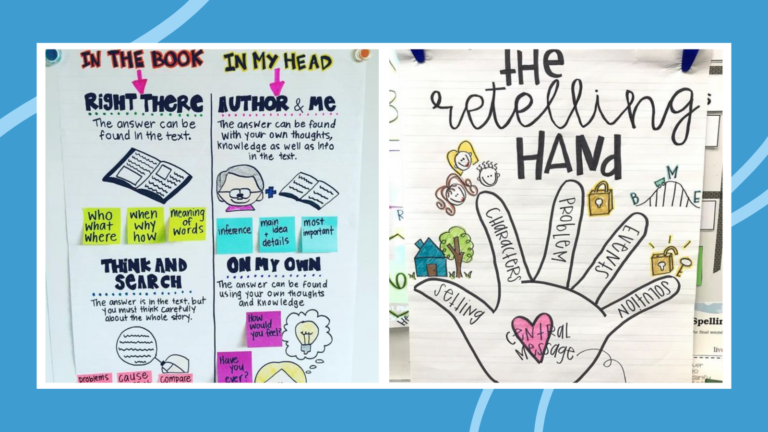
49 Amazing Anchor Charts That Nail Reading Comprehension
Help students learn about characters, setting, main ideas, context, and more. Continue Reading
Copyright © 2023. All rights reserved. 5335 Gate Parkway, Jacksonville, FL 32256
- Skip to main content
- Skip to primary sidebar
- Skip to footer
Out of this World Literacy
Literacy Resources from Jen Bengel
October 3, 2022
How to Teach Narratives Using Anchor Charts and Mentor Texts

Teaching students how to identify and write personal narratives is something we all do each year. Anchor charts are an effective way to help students learn about this genre. It is easy to incorporate both reading and writing during workshop time. Everything that you need to teach this literacy unit is provided for you. This includes the lessons, mentor texts, anchor charts, student recording sheets, graphic organizers, and independent practice. Let's take a look at reading workshop. Although there are 10 genres available for each grade level, we will be focusing on personal narratives. There are enough lessons to help you successfully teach this unit for an entire month.
How to Begin Teaching Personal Narratives

Whether you are teaching personal narrative or another genre, the format for reading and writing workshop remains the same. All of the lessons follow the format above. Start with an introduction. The next step is to model what you are teaching for the class. You can do this by using the mentor texts that are provided for you in the unit.

Then, invite the students to help you as they are thinking out loud while adding their thoughts to the anchor chart. Next, engage all learners as you have them turn and talk and find more examples to add to the anchor chart. You can have them continue using the mentor text. Finally, the students will be transitioned into independent time. Students will apply the skills that they have just learned by using their own books during independent reading time.
Using Anchor Charts
Anchor charts are a great way to model and display the information you are teaching. Start by writing the mini-lesson objective at the top. You can prepare this step and the categories in advance.

Choose a mentor text. This can either be from one of your own books, or from a mentor text that is provided for you. Read the story to the students. Model for the information from the text that matches the mini-lesson. Record this information on the anchor chart. Next, have volunteers point out other information from the story and record their responses on the anchor chart. Finally, have students work together by using a turn and talk. Using collaboration helps to build confidence with students. Record additional information on the anchor chart.

After students have mastered the mini-lesson, send them off to work on their own. Graphic organizers are provided for students to record the examples that they find from their own personal book boxes. The writing workshop lessons build upon the same mini-lesson taught during reading so that students can apply their learning in their writing.
What's Included in the Personal Narratives Unit?
- 20 reading and 20 writing mini lessons all linked to the Common Core and TEKS standards!
- Students note-taking pages for all 40 lessons. Perfect to glue into reading and writing notebooks and keep the learning going all year long.
- 20 printable graphic organizers designed specifically for each reading lesson.
- 20 printable think mark graphic organizers for each reading lesson.
- Writing rubrics for grading.
- Writing editing and revising checklists.
- Sample completed anchor charts for several lessons.
- Mentor texts are INCLUDED! 7 2-page original mentor texts with custom illustrations are included to support the reading and writing lessons.
- TONS of teacher pages for organizing, conferencing, assessing, and note-taking.
Looking for Other Genres?
- Historical Fiction
- Informational
- Personal Narrative
- Realistic Fiction
- Traditional Literature
The above lessons are from the 3rd Grade Literacy Units. To see units for other grade levels, click the links below:
- 2nd Grade Literacy Units
- 3rd Grade Literacy Units
- 4th Grade Literacy Units
- 5th Grade Literacy Units
- 6th Grade Literacy Units
Refer to this blog post on how to set up reading notebooks. 3 Steps to Creating the Best Reading Notebooks
Related Posts

Want more like this post?
Subscribe and receive exclusive news, freebies, and deals.
Enrollment started for In-Person Shadow Teacher 2022-2023 in Santa Clarita city
vargas-Sehested.mdwrite.net
ghost immobiliser Birmingham
Autowatch Ghost Immobiliser Problems
Shop Delta 9 Thc
Delta 9 edible shop
http://Jeil77.com/bbs/board.Php?bo_Table=board0602&wr_id=53183
auto Title Loan
contract Mortgage loan processor
oposlot terbaru
situs slot online
poker online
maxwin server thailand
https://wowslot1919.online
https://lodibet.cloud
online casino review
harley devidson parts after market
bolacasino88
bandar judi 4d
https://goldnovel.com/
รับจัดงานแต่งงาน
see it here
https://london168th.store
https://evoplay-casino-sabong.store
usa88proo.online
sport gambling
jinsungcustoms.com
เกร็ดความรู้
ทัวร์ฮ่องกง
official http://www.betvirtualsportgold.com blog
games online
http://wroclawski.wroclaw.pl/
Yupoo Down Jacket
http://mielecki.mielec.pl/
http://gamesjp.com/jump.php?url=http://warszawski.waw.pl/
http://elblaski.elblag.pl/
http://warszawski.waw.pl/
https://www.xpgamesaves.com/members/7miac9222xdyh9.1505999/
http://stargardzki.stargard.pl/
http://taxibestellung24.de/php/redirect.php?url=http://warszawski.waw.pl/
https://www.toro-bookmarks.win/trentonxxsg311
http://szczecinski.szczecin.pl/
https://iris-wiki.win/index.php?title=Landenuuum192
http://www.med.uz/bitrix/rk.php?goto=http://warszawski.waw.pl/
https://works.bepress.com/5charlottec6485xdgM5
http://www.artscow.com/user/6sophiee4885xdea3-3184082
http://www.chambresapart.fr/user/edmund9f15ftdsc9f
https://www.echobookmarks.win/travisdwiu683
http://www.casinogabon.com wrote
http://www.forum.mieszkaniowy.com/profile.php?mode=viewprofile&u=193085
http://kieleckapilka.pl/profile.php?lookup=149654
http://mylekis.wip.lt/redirect.php?url=http://warszawski.waw.pl/
https://www.muskelbody.info/forum/member.php/87916-4jordanc263xdwB
http://johnnyqsfz666.trexgame.net/beckettoqbj220
https://wiki-planet.win/index.php?title=Brooksmzna324
http://top.stargardzki.stargard.pl
http://new.szczecinski.szczecin.pl
https://websiteslist.net
http://top.szczecinski.szczecin.pl
Discover More
china pills machine maker tablet press manufacturers
Escort in Islamabad
parimatch bd
pinealxt scam
http://top.wroclawski.wroclaw.pl
football gamble
football bet
http://new.radomski.radom.pl
https://zb-2.com
http://radomski.radom.pl/
kiron casino script
http://top.radomski.radom.pl
http://new.wroclawski.wroclaw.pl
https://src.unhamka.ac.id/?id=SLOT1628
coba777 link alternatif
máy xịt rửa xe
slot gacor malam ini
What Does Bocoran Jitu Sdy Mean?
situs 1bandar
เว็บพนันออนไลน์เว็บตรง
Look At This
TrioFus Slot Online Auto Jepe
قیمت لوازم آرایشی
قیمت عطر ادکلن
/%D8%B1%D9%86%DA%AF-%D8%B3%D9%81%DB%8C%D8%AF
Follow on Facebook
Follow on pinterest.

Follow on Instagram
Please go to the Instagram Feed settings page to create a feed.
Session expired
Please log in again. The login page will open in a new tab. After logging in you can close it and return to this page.
The Tech Edvocate
- Advertisement
- Home Page Five (No Sidebar)
- Home Page Four
- Home Page Three
- Home Page Two
- Icons [No Sidebar]
- Left Sidbear Page
- Lynch Educational Consulting
- My Speaking Page
- Newsletter Sign Up Confirmation
- Newsletter Unsubscription
- Page Example
- Privacy Policy
- Protected Content
- Request a Product Review
- Shortcodes Examples
- Terms and Conditions
- The Edvocate
- The Tech Edvocate Product Guide
- Write For Us
- Dr. Lynch’s Personal Website
- The Edvocate Podcast
- Assistive Technology
- Child Development Tech
- Early Childhood & K-12 EdTech
- EdTech Futures
- EdTech News
- EdTech Policy & Reform
- EdTech Startups & Businesses
- Higher Education EdTech
- Online Learning & eLearning
- Parent & Family Tech
- Personalized Learning
- Product Reviews
- Tech Edvocate Awards
- School Ratings
How to Change Your Image: 15 Steps
10 ways to get an uninterested girl to fall for you, 3 ways to get a woman to forgive you, how to make sugar syrup: 11 steps, how to deal with pubic hair: 10 steps, how to field a ground ball: 13 steps, 3 ways to help your wife regain her libido, how to open file explorer: 6 steps, how to make roof trusses: 5 steps, how to eat manuka honey: 9 steps, 15 awesome anchor charts for teaching writing.

1. Parts of Speech Chart: Display the different parts of speech (nouns, verbs, adjectives, etc.) and provide examples for each.
2. Writing Process Chart: Outline the steps of the writing process (prewriting, drafting, revising, editing, publishing) with accompanying visuals.
3. Narrative Elements Chart: Illustrate the key elements of a narrative (characters, setting, plot, conflict, resolution) to help students develop their storytelling skills.
4. Types of Writing Chart: Show different types of writing (narrative, descriptive, persuasive, expository) along with their purposes and characteristics.
5. Transition Words Chart: List common transition words and phrases to help students improve the flow and coherence of their writing.
6. Sentence Structure Chart: Present various sentence structures (simple, compound, complex) and provide examples of each for better sentence variety.
7. Grammar Rules Chart: Highlight essential grammar rules (subject-verb agreement, punctuation, capitalization, etc.) to reinforce proper writing mechanics.
8. Figurative Language Chart: Introduce different forms of figurative language (similes, metaphors, personification) and provide examples to enhance students’ descriptive writing.
9. Editing Marks Chart: Display commonly used editing marks to help students self-edit and revise their writing for clarity and correctness.
B Showcase a variety of graphic organizers (mind maps, Venn diagrams, story maps) to assist students in organizing their ideas before writing.
11. Persuasive Techniques Chart: Identify persuasive techniques (rhetorical questions, emotional appeal, evidence) to help students craft compelling arguments.
12. Writing Conventions Chart: Explain writing conventions (spelling, capitalization, punctuation, paragraphing) that students should adhere to in their writing.
13. Word Choice Chart: Offer alternative words to common, overused terms to encourage more precise and engaging writing.
14. Revision Strategies Chart: Suggest different revision strategies (peer review, reading aloud, changing sentence order) to help students improve their writing.
15. Writing Traits Chart: Discuss the six traits of effective writing (ideas, organization, voice, word choice, sentence fluency, conventions) and provide examples for each trait.
These anchor charts can be displayed in the classroom to serve as quick references for students, reinforcing essential writing skills and concepts. They can also be used as teaching tools during writing lessons, promoting greater understanding and application of writing strategies.
How to calculate net realizable value
How to calculate net revenue.
Matthew Lynch
Related articles more from author.
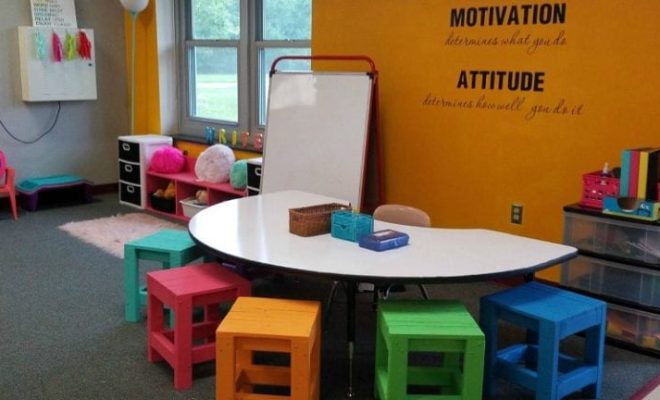
Minimalist Classroom Design: Why It’s Effective & How to Do It

Motivating Students by Thinking Outside of the Box
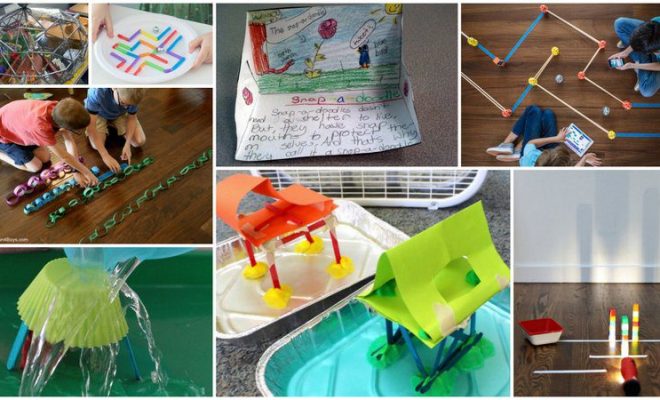
15 Kindergarten STEM Challenges That Little Ones Will Love
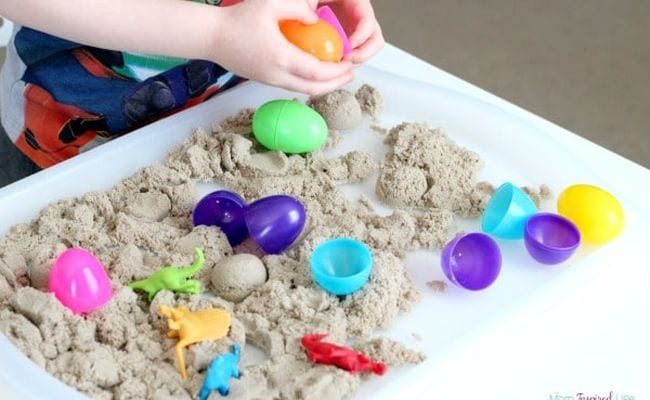
17 Satisfying Kinetic Sand Activities for PreK and Elementary School

Don’t Forget About Pedagogy When Chasing Technology!

Activities to Teach Students to Identify Trapezoids
Home » Anchor Charts » 17 Engaging Personal Narrative Anchor Chart

17 Engaging Personal Narrative Anchor Chart
As teachers, we’re always looking for ways to make our lessons more interactive and engaging. However, it can be challenging to find activities that are interesting and fun. You also want to deliver a lesson that keeps students focused on the task rather than what they’ll be eating for lunch or what they will do after school. That’s especially tricky when teaching a complex topic like personal narrative writing .
As you’ll probably already know, in personal narrative writing activities, students create an account of a specific life event using the first-person point of view . It’s a type of creative writing that can spark meaningful discussions among classmates and the teacher.
Anchor charts are great visual tools that help you and your students better understand concepts and ideas that are new or difficult to grasp. In addition, anchor charts help your students understand and retain information in the long term. They are easy to make and can be done in a few minutes.
Table of Contents
Elements of a good personal narrative anchor chart, introduce the elements of good personal narrative writing, different ways of presenting personal narrative anchor charts, teaching personal narrative – resources from teach simple, other personal narrative resources.
For writing assignments like personal narrative writing, you can ask your students to create their own anchor charts that include key terms and concepts. Alternatively, you could get their creativity flowing by drawing up a chart of literary devices like metaphors, similes, personification, etc. You could include examples of each concept on your chart to help your students better understand the information – the more creative, the better!
Personal narrative writing is more effective if students understand the essential elements of good writing. Some of the key elements you could illustrate in your chart are:
First, you need to include basic story elements that still apply to personal narratives. These include:
The sequence of events or plot
A plot is a plan for a narrative, including its beginning, middle, and end, characters, and setting. A plot functions as a roadmap for your narrative, showing readers where it is headed and what surprises lie ahead.
The setting
The setting of a story isn’t just about location; it also includes time period, weather, and mood. The setting is more than just a backdrop; it plays an integral part in the story. It may be set at any time or place as long as it is clearly defined. The setting establishes the story’s tone, mood, and characterization.
Developing well-rounded characters
Even though it is a personal narrative, the reader won’t necessarily know the author or their backstory. Good stories are driven by characters. Characters also serve as readers’ eyes, filtering the story’s events through their perspective. Besides shaping the plot, characters push the story forward.
A problem and a solution
A personal narrative, like any story, doesn’t necessarily have to be a harrowing tale about stopping an evil genius from taking over the world or solving a crime. Instead, it may be about an account of the student trying to convince their parents to get them a new bicycle or banding together with friends to outwit a bully. Anything can be a problem. A tangle between characters, a choice to be made, or a predicament to be overcome. It must, however, be solvable. If a problem is not solvable, it will not make a decent story.
Once you have reestablished these elements, you can start to introduce more specific details that will support a personal narrative
The narrative structure
Authors have to keep their narratives focused by not introducing too many characters or too many places the characters visit. You can create an anchor chart that lists the aspects of a good story. Students should consider where and when their memories or events occurred, create a precise sequence of events, including important details, and keep the narrative focused on the small moment.
Finding their voice
As a writer, you should use your voice to express your feelings, develop your characters, and express your ideas clearly and concisely.
This is a crucial element of all types of writing, but it’s essential in personal narrative essays. Students shouldn’t try to write exhaustive biographies in 500 words. Instead, they should write just enough to give readers insight into their personalities and experiences without going overboard.
Authenticity
Students should try writing their narratives as if they’re speaking to readers in person. This will help them avoid sounding overly formal or self-conscious. An authentic, casual style does more to connect with readers than anything else.
Specificity
Personal narratives shouldn’t be a series of general observations about life. They should focus on a specific event or series of related events.
So, how would you illustrate these points on a chart ? Here are a few ideas.
There is no wrong or right way to put an anchor chart together. It’s meant to be a creative process that helps you simplify concepts, making them easy for your students to take in. So here’s a little inspiration to get the creativity flowing.
Introduce structure
Students will be expected to create narratives throughout their education. Break down narrative writing into personal and fictional versions. Writing personal narratives help students improve their fictional writing skills, as well!
Hints and tips
This chart leads your students through the process of writing a narrative essay. You can model the process by using this in your pre-planning and writing/answering each of these components. For example, start by writing down a small moment from your life, then write down a catchy lead, and so on.
Personal narrative checklist
Checklists are an excellent tool for making students feel self-reliant and confident to tackle the task.
Focus on small moments
How do you eat an elephant? One bite at a time!
Draw it out
Younger children find it easier to express a narrative through drawing, especially when their writing skills are just beginning to emerge.
A Student’s Guide to Writing a Personal Narrative
Whether you are teaching in-person or doing distance learning , this resource is perfect for teaching your students how to write narratives.

Bilingual narrative writing graphic organizer
These worksheets will help students brainstorm and develop ideas before composing their narrative writing piece. They are available in English and Spanish.

My November journal: creative writing prompts
This journal is the perfect way to get your students to write daily and feel comfortable about their experiences.

Writing a memoir
This unit provides teachers with a four or five-week that includes daily lessons to help students delve deeply into memoir reading and writing.

Display charts filled with tips, checklists and reminders
Have a selection of visual reminders and tips on display, so your students can refer to them whenever they need a confidence boost.
Keeping focused
Students can become better writers by learning and practising moment writing. For example, personal narratives typically turn into lists of events. Still, students can see how much more meaningful their writing becomes by focusing on the most important moment.
Personal narrative graphic organizers
Giving students a planning tool to organize their thoughts will do wonders for their writing process. In addition, they can be adapted to suit the grade level and expectations.
Complete units
Aren’t we lucky we live in a time where we can share resources and ideas. So many bundles and complete units are available to kick-start our creativity and save us some precious time.
Thought starters and prompts
There are many reasons why children may need thought starters or writing prompts. For some children, these can help to stimulate their creativity and get their ideas flowing. For other children, it may be a way to help them focus on a particular topic or theme . Whatever the reason, thought starters and writing prompts can be a helpful tool for children in the writing process.
Mentor texts
Students should be exposed to a good example or two before they start writing their own personal narratives. Choose a powerful, engaging personal narrative mentor text to inspire them.
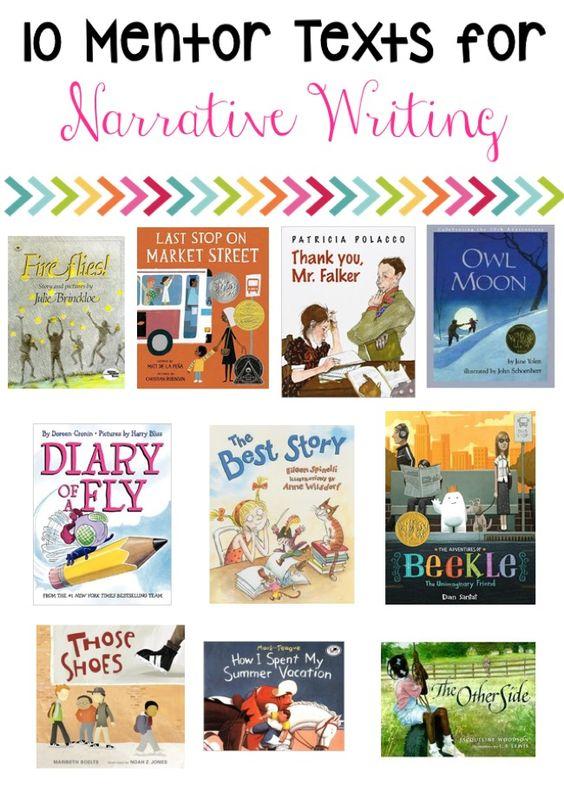
Personal narratives are powerful tools for connecting with others. They can help students make sense of their experiences and gain confidence in writing and sharing their stories. But it can be challenging to teach them how. As a teacher, you want to help your students understand the information they are learning and retain it long after they have left your classroom. Anchor charts are great visual tools that help your students better understand the concept of a personal narrative and organize their ideas .

By Nicola K Nicola lives in Johannesburg, South Africa. Before starting her career as a writer, she specialized in gifted education and now writes about education and supporting parents and teachers of children who are “different” according to commonly-held views.
Share Article:
Download unlimited teaching resources, join free today, teach simple.
The team behind Teach Simple is a small but dedicated group who are passionate about education and making a positive impact on the lives of teachers and students.
We have a lot of interesting articles and educational resources from a wide variety of authors and teaching professionals.
29+ Multiplication Anchor Chart to Count On
9+ inspiring narrative writing anchor chart.
Last Updated on July 17, 2023 by Teach Simple
Narrative Writing Anchor Chart - Story Elements Anchor Chart

Also included in
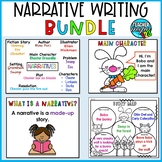
Description
Engage your class in the power of visible learning with these Anchor Charts #TPTSparklers21! Anchor Charts are an interactive and collaborative learning tool that helps students to activate prior knowledge, foster critical and creative thinking skills and expand on ideas.
- This pack of PRINTABLE labels makes creating purposeful Anchor Charts a breeze!
- Print, cut and paste labels prior to your lesson and watch how these prompts expand students' ideas and thinking.
- Provide students with a variety of coloured markers and invite them to contribute their ideas under each label/heading.
- DIFFERENTIATE by encouraging demonstration of visual thinking - e.g. drawing pictures, labels and arrows.
- Display completed Anchor Charts and regularly refer to them at the beginning of a lesson to recap previously taught concepts, skills and knowledge
- Refer to Anchor Charts also at the end of a lesson as a closing plenary.
- Anchor Charts provide a strong visual support scaffold scaffolding to students while they are at their desks working independently.
- Students love to see Anchor Charts displayed in their classroom as they feel a sense of accomplishment in contributing their ideas and co-creating an important learning tool.
- These Anchor Chart prompts look professional and make excellent environmental displays for Open House for students to discuss the acquired skills, concepts and knowledge with their families.
- Simply print, cut, paste and co-create as a class!
Questions & Answers
Teacherinspo123.
- We're hiring
- Help & FAQ
- Privacy policy
- Student privacy
- Terms of service
- Tell us what you think

IMAGES
VIDEO
COMMENTS
Here are a few examples of narrative writing anchor charts you may create. 1. Elements of a Narrative. One of the first steps in introducing students to narrative writing is showing them the important parts of the piece. Here are the most important ones upper elementary students should see on a narrative writing anchor chart.
A good narrative anchor chart should include: An outline of the overall structure of beginning, middle and end that makes a good story. An explanation of the internal structure of a good story: hook, problem, action, climax, solution. A clear statement of the elements one needs in a narrative: characters, problem/s, setting, solution.
Choose one or more to share with your class! 1. Basic Story Elements. This anchor chart is excellent for kindergarten or first grade. It lays out the basic story elements, leaving room to add information with a marker or sticky notes. Source: The Animated Teacher. 2.
You can grab a free set of anchor chart-toppers and examples for teaching your personal narrative writing unit. Everything you need to prepare your anchor charts before filling them in with your class! I'd love to see how you use your narrative writing charts! Tag me on Instagram or send me your photos at [email protected].
Teaching Plot Anchor Chart By First In Line. These four anchor charts provide a visual representation of the plot of the story. The first chart is finished; the following three are blank. These charts may be used to create a display bulletin board or fill in the blanks in students' interactive reading notebooks.
First, students will need to know what Narrative Writing is! Students will be tasked with writing narrative stories throughout their education. The anchor chart above divides the topic into personal and fictional narrative writing. Initially, students will be writing stories about events that they experienced, personal narratives.
4. Conflict Types Chart: Introduce students to different types of conflict, such as man vs. man, man vs. nature, man vs. self, and man vs. society. Provide examples of each type to deepen their understanding. 5. Theme Chart: Explore common themes found in literature, such as love, friendship, courage, or perseverance.
Here are a few ideas for anchor charts as you are planning your narrative writing unit. 1. Thinking of ideas. Narrative writing tells a story and a personal narrative tells a story from your own experiences. Discuss personal narratives, important parts to include in a personal narrative, and how to think of ideas for your personal narrative.
Here, we have compiled 15 clever anchor charts that can be used to teach story elements effectively in the classroom. Character Traits Chart: Create a chart that lists various character traits, such as brave, curious, or dishonest. Show examples of characters from different stories and ask students to identify and explain the traits that apply ...
Below you'll find printable story elements anchor chart resources. As both readers and writers, it's important to understand story elements. This can help readers comprehend the depth of work that goes into crafting a story and provide multiple avenues for analysis. With characters, setting, symbols, and themes, there's much to consider ...
28. Show, Don't Tell. "Show, don't tell" is a cardinal rule of writing. This anchor chart, best for upper elementary writers, can be used to strengthen scenes in fiction and narrative nonfiction works. Build out this chart for middle school writers with additional ideas and more complex emotions.
Using Anchor Charts. Anchor charts are a great way to model and display the information you are teaching. Start by writing the mini-lesson objective at the top. You can prepare this step and the categories in advance. Choose a mentor text. This can either be from one of your own books, or from a mentor text that is provided for you.
Learning About Setting Anchor Chart By First In Line. This anchor chart begins with a simple definition, and then lists examples under three columns: place, time, and environment. Some bonus tips are given underneath. This printable PDF also includes a couple of fill-in-the-blank sheets for students to fill out.
A narrative writing anchor chart is a visual prompt that helps children plan and prepare for a creative writing exercise. Each child can personalise their own, so they can include whatever they find the most useful. For example, a child who struggles with structure could include core plot points or story arcs. Children can also include drawings ...
The narrative writing posters include a description of the following aspects of narrative text structure: Exposition - this is the beginning of the story, where the setting, the characters, and the plot are introduced. Conflict - this is a problem or challenge that the characters need to solve or overcome. Rising Action - these are the ...
1. Parts of Speech Chart: Display the different parts of speech (nouns, verbs, adjectives, etc.) and provide examples for each. 2. Writing Process Chart: Outline the steps of the writing process (prewriting, drafting, revising, editing, publishing) with accompanying visuals. 3. Narrative Elements Chart: Illustrate the key elements of a narrative (characters, setting, plot, conflict, resolution ...
elements of a narrative with the class. • Language Ask questions about the writing process. MATERIALS Anchor Chart W1: Steps for Writing Anchor Chart W4: Presenting Work Online TEACHER TIP For children who need extra help with understanding the elements of a narrative, review each element within the context of a familiar fairytale. Then ask
Differentiation Corner. 4.9. (18) $1.75. PDF. This narrative writing anchor chart has examples of temporal or transition words and phrases for sequencing within narrative writing. These words help move the story along and show event order in creative writing and short stories in an appropriate sequence.
Elements of a Good Personal Narrative Anchor Chart. For writing assignments like personal narrative writing, you can ask your students to create their own anchor charts that include key terms and concepts. Alternatively, you could get their creativity flowing by drawing up a chart of literary devices like metaphors, similes, personification ...
Use the anchor chart to create a personal narrative checklist. Pause after each point in the anchor chart to discuss examples or read from a personal narrative mentor text. Click here to see a list of mentor texts. If you teach multiple classes or you want to reuse the same anchor chart next year, leave the thought bubbles blank and add student ...
WHAT'S INCLUDED:Genre Poster/ Anchor Chart: This poster contains a student-friendly definition of the genre, a visual, elements of the genre, and an example of a book in the genre. It comes as a poster or interactive anchor char. Subjects: English Language Arts, Literature, Reading. Grades: 3 rd - 6 th. Types:
A narrative writing anchor chart is a visual prompt that helps children plan and prepare for a creative writing exercise. Each child can personalise their own, so they can include whatever they find the most useful. For example, a child who struggles with structure could include core plot points or story arcs. Children can also include drawings ...
Narrative Writing Anchor Chart - Story Elements Anchor Chart. Rated 5 out of 5, based on 1 reviews. 5.0 ... Writers Workshop Unit BUNDLE consists of sequenced writing activities and includes anchor charts, a narrative . 4. Products. $9.99 Price $9.99 $14.50 Original Price $14.50 Save $4.51.